It’s been about 5 months since Garmin first introduced the Vivoactive 4 series (alongside the Garmin Venu). Both watches, screen aside, are nearly identical. And in that time Garmin has also introduced a number of themed Vivoactive 4 variants (such as ones from Star Wars, Avengers, and Captain Marvel). However, they’ve also quietly tweaked a number of features in the Vivoactive 4 – making it a bit more polished than it was on launch. Minor things you might not notice, like prettier end of workout screens with maps and HR charts.
The main appeal of the Vivoactive 4 was adding in a second button – making it easier to use for sport scenarios, but also a slew of more general fitness features. Aspects like structured yoga workouts. And unlike the Vivoactive 3/Vivoactive 3 Music, all editions of the Vivoactive 4 have music. There’s just now a smaller one (Vivoactive 4s) and a bigger one (Vivoactive 4). Plus all those special edition ones.
Now, despite having used the Vivoactive 4 on and off since August, I hadn’t quite got around to writing a review. You’ll remember I published my Garmin Venu review in earlier December after a number of months. And then the day after that I switched over to the near-identical Vivoactive 4. And it’s been on my left wrist since then. So, tons of usage, and tons of workouts in the bag. Thus, review time.
Note that while initially I was using a loaner media Vivoactive 4 from Garmin, that’s long since gone back to them. Since then I’ve been using my own Vivoactive 4 that I went out and got myself. If you found this review useful, you can hit up the links at the end of the post like usual to support the site.
What’s New:
The Vivoactive 4 is, as one might assume, a progression of the Vivoactive lineup. However, it’s worth noting that so is the Venu. The Vivoactive 4 and Venu share virtually every feature, with the only differentiating aspects of the Venu being those that are specifically display driven. So such things as higher quality animations and better quality watch faces on the Venu over the Vivoactive 4. In discussing the features with Garmin, there are no non-display associated features that are in Venu that aren’t in Vivoactive 4, or vice versa.
The other thing to note is that previously there were separate editions of the Vivoactive lineup – one for music (e.g. Vivoactive 3 Music), and one for non-music (Vivoactive 3); now that’s all under a single umbrella with music – whether you have Venu or Vivoactive 4. On the flip-side, you now have two different sized units, and things cost more. The pricing is as follows:
US Pricing:
Vivoactive 4/4S US Pricing: $349
Venu: $399
EU Pricing:
Vivoactive 4S: €279 & €299 depending on bezels/buttons
Vivoactive 4: €299 & €329 depending on bezels/buttons
Venu: €349 & €379 depending on bezels/buttons
Though, we’ve already seen cracks in that pricing. Back at Christmas things were down to $299USD, and even right now they’re $25 off and Venu is $50 off. I suspect that’ll become the new norm for most of 2020.
With that, let’s talk all the new offerings in relation to the past model – the Vivoactive 3:
– Music now standard: Including Spotify, Amazon Music, and Deezer
– Vivoactive 4 is 45mm and includes a color touchscreen display
– Vivoactive 4S is 40mm and includes a color touchscreen display
– Added secondary button to side: Used for lap, back, menu access
– Added hydration tracking to manually track liquid intake with widget and app
– Added Estimated Sweat Loss post-workout
– Added Respiration Rate for all-day and sleep metrics (and certain workout types)
– Added Breathwork Exercises (way different than simple breathing stress features)
– Added Workout Animation functionality: For Strength, Cardio, Yoga, Pilates
– Added new Yoga and Pilates Built-in workouts: Includes step by step animations
– Added ability to design Yoga workouts in Garmin Connect: Complete with step by step pose animations
– Added ability to design Pilates workouts in Garmin Connect: Complete with step by step animations
– Added PulseOx for 24×7 blood oxygen tracking
– Revamped health stat widget akin to latest Fenix/Forerunner models
– Switched to Sony GPS chipset like remainder of Garmin 2019/2020 unit lineup
– Switched to Garmin Elevate V3 optical HR sensor
– Battery life at 8 days standby for the VA4 and 7 days for the VA4S, and 6 hours of GPS+Music
As you can see, the vast majority of new features on the watch are far less focused on the swim/bike/run athlete that’s more common in Garmin’s Forerunner and Fenix lineup, and instead focused on a bit more of the lifestyle athlete that may be more varied in their day to day activity – which to be fair, was always the strength/target of the Vivoactive lineup, as this is within that family.
Also, as noted there are two sizes of the Vivoactive 4 (the 4 and 4S), however, feature-wise they’re identical.
Though battery-wise there are some differences:
Smartwatch mode (no GPS): 8 days for the VA4, 7 days for the VA4S
GPS time (no-music on): 18 hours for the VA4, 15 hours for the VA4S
Music + Animations in Strength Workout + Workout: 4.5 hours on the VA4, 3.5hrs on the VA4S
Finally, for those not familiar with the wider Vivo lineup, here’s all the baseline features found on both the Venu & Vivoactive 4:
– GPS tracking of activities (no reliance on phone)
– Workout tracking of range of sports including running, cycling, pool swimming, skiing, golf, gym and many more (full list down below)
– Structured workout support via downloadable workouts
– Quick on the fly intervals
– Training calendar support
– Optical heart rate sensor in watch
– 24×7 tracking of steps, stairs, calories, and distance
– Smartphone notifications from iOS/Android
– Garmin Pay for contactless payments
Since release, virtually all of the new Vivoactive 4 & Venu health/fitness features have also worked their way into the Fenix 6 lineup, and some also the FR945 and FR245. As is common with the Garmin ecosystem, I would not expect any of these new features to make their way back to the Vivoactive 3. Of course, bits like the screen are hardware driven. I would, however, expect that the Venu and Vivoactive 4 will stay largely lock-step in their firmware updates/features.
Unboxing:
The Vivoactive 4 & 4S are identical from an unboxing standpoint. So I’ll go through the parts of the Vivoactive 4 slowly, and then just dump a pile of photos from the Vivoactive 4S variant at the end. Seems fair, no?
The box from the Vivoactive 4 follows the same design as…well…basically every other Garmin box:
Crack it open and you’ll find the Vivoactive 4 chilling inside looking up at you, hopeful of its life ahead. Of course, you’ll likely beat the crap out of it with all that sportiness you’re planning.
Inside the box you’ve got exactly four things:
1) The watch
2) The USB charging/sync cable
3) A paper quick start guide you’ll ignore
4) A warranty card you’ll also never read
See, here’s the family photo:
Here’s the back of the Vivoactive 4. There’s a small serial number sticker on it in this photo. It didn’t last but a week or two.
And here’s the charging cable. It’s the same charging cable used on the majority of Garmin wearables in the last few years.
And finally, here’s the weight of the watch. The Vivoactive 4 comes in at 51g:
And here’s the Vivoactive 4 and Vivoactive 4S side by side:
Oh, and a quick unboxing gallery of the Vivoactive 4S:
Got all that? Good, let’s get to using it!
The Basics:
If you’re looking for a complete user interface overview, simply hit the Play button below. I go through everything from the basics of activity tracking to guided yoga workouts to music and payments. Plus much more.

But, if videos aren’t your thing – no worries, I’ve still got you covered. First up we’ll start with the watch faces. Like all Garmin watches, you can customize these watch faces from a pile of pre-loaded ones, or you can download 3rd party ones, or make your own watch face (such as from a photo).
To download custom watch faces, simply download the Connect IQ app, which accesses the Connect IQ app store. That includes not just watch faces, but also apps and data fields for the Vivoactive 4:
The Vivoactive 4 is an always-on watch, meaning the display never turns off. While this is how every Garmin watch except the Venu works (and even that has an always-on option too), it’s not as common within the more broad smartwatch world. So, I just wanted to point it out. Within this mode the battery life is claimed at “up to 8 days” for the Vivoactive 4, and 7 days for the Vivoactive 4s. I’d say things are roughly in that ballpark given I’ve got daily workout usage that would decrease that. Given it’s winter and I’m doing less outdoor GPS activities and more indoor workouts, my battery life is slightly skewed, but I’m getting through the majority of the week on a single charge with daily ~1hr workouts, and about 1-2 of those are outdoors with GPS. I usually make it about 5, maybe 6 days, on a single charge.
Backlight settings will impact that, which are customizable within the settings menu. This includes things like raise to wake (to turn on the backlight). Though, the display is perfectly visible without a backlight in all conditions except a pitch-black room. Fwiw, the display’s backlight is bright as heck, and I’ve used it almost every night to change an infant’s diaper at 4AM in a lightless room. Welcome to my world.
Going back a bit to the basic interface – it’s a touch screen, however with the Vivoactive 4 they’ve added a secondary button. I find the two button shifts a huge upgrade. I was never a fan of the singular button design. But the two buttons are spot-on for their purpose, especially in sports (to have a dedicated lap vs start/stop button).
From the main watch face you can swipe up/down through what are known as widgets. These widgets display all sorts of health and fitness information (and you can download 3rd party ones too). They also provide quick access to apps like Spotify. For example here’s the Garmin Health Stats one, which allows you to see things like heart rate, stress, body battery, and breathing rate in one quick glance:
Or the ‘My Day’ widget, which summarizes most of your basic fitness metrics:
You can see how each of the statuses is further detailed once you tap on it:
Anyway, back to the basics and new features. There’s the new hydration tracking functionality. The way this works is that you define three ‘vessels’ (or cups, as you see them), and each of these are basically custom containers. So Cup #1 could be an 18oz bottle, cup #2 could be an 8oz cup, and cup #3 could be whatever else you want. Anytime you tap on that cup it automatically adds the appropriate amount of tracked liquid. Presumably it’s water, but perhaps you’re going for an extensive bar hopping, it could just be beer.
All of this can be customized to metric instead of cups, by the way. And you can add water within Garmin Connect Mobile and it should merge together (right now that’s not working for me). The whole point of this is largely water tracking. For those trying to lose weight, one of the best ways to support that is drinking lots of water (for a variety of reasons that Google can help on). You’ll see your goal progress (as defined in settings on the app) around the outside, and a little animation when you achieve it. If configured, the Vivoactive 4 will remind you every 2 hours (10AM, 12PM, 2PM, etc…) to log how much you’ve drank.
Garmin is approaching this feature much like the female menstrual tracking functionality they added this past spring in that it’s technically a Connect IQ widget that’s pre-loaded onto the Venu/Vivoactive 4 watches, but we’ve already seen it expand to other watches.
Next, there’s the new breathwork features. Now, unlike typical “slowly breath in and out” features we’ve seen on various watches, this is at an entirely different level of breathwork, often called mindful breathing.
It’s here you can choose a specific breathing technique:
And then it’ll guide you through it, with the count-down timer slowly moving in and out as the rings:
Now in certain activities you’ll also get the new respiration rate data. The new respiration rate feature does not require a heart rate strap, and is working constantly behind the scenes within the optical HR sensor to measure respiration rate (basically, breathing rate). You can see it on a dedicated widget on the watch – inclusive of trending over the last 7 days:
And here’s the data from within Garmin Connect Mobile:
The Vivoactive 4 and Venu both have PulseOx measurement as well, joining the growing list of Garmin watches that have the capability. You can toggle it to automatically measure 24×7, just at sleep, or only on demand:
As with my past experiences with this, I’d take this with a grain of salt. However, if you do take measurements you should roughly follow exactly as would be done in a medical setting: Keeping it snug, while seated, and not moving. Also, keep in mind it’s a battery blowtorch. If you turn it on, you’ll significantly increase how often you have to re-charge the watch.
Next, there’s sleep tracking. This works automatically behind the scenes on your watch. You won’t see the data on the watch, but rather on Garmin Connect Mobile/Web. I find that it’s generally pretty good for me, even despite having a newborn at home that has me up at all weird hours of the night. However, I do find that sometimes if I’m up at say 6AM, and then fall back asleep for another hour till 7AM, it won’t always catch that last little bit if it’s super short and the sleep quality isn’t good. But, by and large, it’s a perfectly fine yardstick for me.
Note that I don’t have any way to judge the whole deep/light sleep bits. So I mostly ignore it. Just like Garmin totally ignores naps. It has no way to account for naps unfortunately – so these don’t count anywhere. Also, those rare 10hr days were due to glorious jetlag of flying from Europe to Australia and back.
Beyond these features, you’ve got smart notifications just like on past Garmin watches. Note that the watch isn’t just limited to text messages. You’ll get anything you’ve configured on your smartphone for notifications. You can see a variety of notifications here as well as some YouTube ones:
Finally, there’s also calendar sync too – which automatically syncs to the watch from whatever calendars you’ve got set up. As does weather too. All of which are up in the widgets gallery a bit earlier.
Oh, wait – one more thing – here’s a huge gallery of many of the widgets. There are more than this, but this is what I have configured on my watch at the time:
Now that we’ve covered virtually all the basics, it’s on to the sporting realm!
Sports Usage:
In the previous section I talked about many of the health features like hydration, breath work, and activity tracking, but for this section I’m going to slide into the sport elements, including bits like running and the new animations related to indoor workout types. I’ll first cover these new features and then from there we’ll look more closely at the sport modes for sports like running, including data field and settings configurations.
We’ll start though with the new workout animations. This concept isn’t new to the industry, in fact Fitbit did it years ago. The idea being to give you guidance on how to move your body into positions for certain workout types like strength, cardio, yoga, and Pilates. Since these types of workouts are most prone to being done incorrectly from a body form standpoint, the thinking is to show you exactly what you should be doing for each movement. Atop that, Garmin has included some 41 different structured workouts between those categories.
To begin on this journey, we’ll dive into the sport menu. It’s here that you can choose any sport, be it running or cycling, or in our case – Yoga:
Next, we’ll swipe up and choose ‘Workouts’. This is where we can select from one of the pre-canned workout routines. Just like a guided workout at your local studio, minus all the bendy people around you.
After you’ve selected one, it’ll specify and show you how many steps it has. In this case our workout, ‘Wake up, Energize’, has 77 steps. Which sounds like a lot, but each time you do a pose that’s considered a step, so is any rest period between them. As well as any repeats. It goes by faster than you think.
If we press to view one of the steps, we’ll see the number of seconds listed next to each one. You can see how at this pace things would go pretty quickly.
However, if you tap one of those steps you’ll get a short animation showing you that specific pose:
You can go through any of the steps if you want to ahead of time. Or you can just skip that and simply tap to start the workout. Which is what we’ll do. It’s at this point the timer starts, and it begins recording (including your heart rate behind the scenes). You’ll see that it shows a green circle around the outer edge of the watch, acting as a timer that slowly closes as the time completes.
You can also swipe to the next screen to get a different style count-down timer clock. However, you’re essentially along for a ride here. When the time for that pose is up, it’ll vibrate your wrist and display the next pose/instructions.
And finally, you can also display a normal data field layout, including your breathing rate and heart rate, as well as stress score.
Both the stress and respiration rate data fields are new to Garmin with the Vivoactive 4/Venu lineup, and were specifically put in there for the Yoga activity. Of course, you can ignore this data during your session if you want. That’s because all the data is recorded, so once you finish your workout it’ll give you a workout summary that lists your poses, timings, and breathing rates. Now the overall poses/animations concepts are essentially the same whether you’re in yoga, Pilates, cardio, or strength. Obviously the specifics for each workout are different, but the way the Garmin unit works is the same. With strength training, you’re also getting rep-specific information too.
However, where it really starts to get interesting is that you can create your own workout from Garmin Connect/Garmin Connect Mobile:
Note though that you won’t see any of the animations when you build your own workouts. So that’s a bit of a bummer.
From here let’s switch back to some traditional Garmin sport features. As you saw earlier, there are boatloads of sports to choose from. Even boat ones like rowing too. Many of these are customized to the specifics of the sport. For example, running is pretty straightforward, but something like downhill skiing/snowboarding will actually automatically count your runs and vertical, pausing correctly each time you take the lift back up.
To start a sport mode, from the main watch face you’ll simply tap the upper right button. You can then customize your favorites here, so that the ones you use most often are at the top of the list. In our case, we’re going to select Run by tapping it:
Depending on the sport mode, it’ll start the GPS acquisition process. The GPS status is then shown at the top of the watch, and will go solid green once acquired. In most cases it’ll just take a few seconds to find GPS. In fact it downloads GPS pre-cache data from your phone to find satellites faster. It’ll also show any sensors you’ve got paired, as well as the status of the optical HR sensor:
Oh, and sensor-wise it supports: heart rate, headphones, cycling speed/cadence, running footpod, Tempe (temperature sensor), ANT+ cycling lights, ANT+ cycling radar, as well as golfing club sensors. Note for most of those above it’ll support both the Bluetooth Smart & ANT+ variants of them.
Back on the Run starting screen, you can swipe up from the bottom to go ahead and do a custom workout. These would be if you downloaded a workout from Garmin Connect or made one online or via the Garmin Connect Mobile smartphone app. In other words, if you made your own fancy interval workout, or have a training plan loaded (like a 5K/10K/etc plan, all of which Garmin has for free). Garmin also has pre-loaded a few individual workouts in here too.
You can customize any of your sport screens. You can do so within the settings on the watch itself (still not on phone app). You get three customizable screens, each with up to 4 data fields on them. You’ll also get a heart rate gauge screen too.
You can further configure bits like auto lap (distance based), auto pause, auto scroll, and the GPS type (GPS/GPS+GLONASS/GPS+GALILEO):
The Venu uses the same Sony chipset as every other Garmin watch released in 2019 (and every other watch released in the last year+ from Suunto, Polar, and COROS). We’ll get to GPS accuracy later.
With all that set, we’re ready to run. Simply press the upper right button again. Just pretty much like every other GPS watch out there it’ll show your running stats in real-time, including your pace, distance, time, heart rate, and any other metrics you’ve added.
And here’s the heart rate gauge page:
From a lap standpoint you’ve got both automatic laps (which you can define), or manual laps by pressing the lower right button to trigger a new lap. If you want to stop your workout (or start again), press the upper right button. Once you’ve paused the workout, then you’re given the option to save or discard it.
If you choose to save it, it’ll show any PR’s and VO2Max changes first:
Then it’ll show you the summary screen. This screen has actually been updated considerably since the Vivoactive 4 launched. Now it shows both a breadcrumb outline of your run (like Garmin’s higher-end Fenix 6 & Forerunner 945 watches), but also shows a nifty heart rate chart of your run:
After that, you’ll also get run totals, lap splits, and time in zone.
Of course, all of this goodness is transmitted to Garmin Connect & Garmin Connect Mobile using WiFi or Bluetooth (depending on what’s in range). Then in the smartphone app you can pull up any of the stats for that workout:
It’s also on Garmin Connect online (website). Here’s an example of one, but you can click on this link to see the full thing and zoom around and such yourself.
Atop that, if you’ve got an account on Strava, MyFitnessPal, TrainingPeaks, or a pile of other apps – it’ll send the file immediately to them as well. It usually shows up within a few seconds of you finishing your activity. Here’s a run on Strava from the Vivoactive 4:
Last but not least, there’s the newish Garmin Safety & Tracking features. These started rolling out last spring to Garmin watches, and are now baseline on most units including the Vivoactive 4 and Venu lineup. These are grouped into roughly two buckets:
– Incident Detection: If you crash your bike, or fall while running and walking (you can configure individually)
– Assistance Alerts: Will send an emergency alert to predefined contacts with your live GPS location
The assistance alerts are loosely based atop Garmin’s LiveTracking features, which are also available as well (so you can share your live location with friends/family each time you start a workout). Again, the main goal of assistance alerts is if you’re somewhere you feel unsafe and want to semi-discretely let someone know you may be in trouble – holding that upper right button for three seconds will start the alerting process. However, all of these require your cell phone to be within range (since it uses that for cellular connectivity).
For the crash/incident detection, I’ve not yet had it false-trigger on the Vivoactive 4. I have had it false-trigger on the Venu once (in 3-4 months) and a few other units prior to that. The algorithm is looking for a high-g impact event followed by no movement (I was waiting for friends to catch-up). Still, you can simply cancel it within 20 seconds. For safety assistance alerts, you’ve only got 5 seconds though (those require holding it for 3 seconds though). Given it’s winter and I’m riding outdoors less, that’s probably why I haven’t seen much there.
So about now you may be wondering how the Venu/Vivoactive 4 differs from a sports standpoint compared to something like the Forerunner 245/245 Music. The main thing is around the physiological tracking – so bits like training load or recovery, which aren’t tracked on the Vivoactive/Venu series. Additionally, there’s also course following (so the ability to follow a specific route navigationally).
However, inversely, the Venu/Vivoactive 4 actually has a barometric altimeter, while the FR245 doesn’t. A slightly odd quirk in Garmin’s watch hierarchy. In addition, the FR245 doesn’t have the advanced yoga, Pilates, or related animations either. In other words, it’s still a bit of a confusing mess to figure out which watch has which features.
Music:
With all editions of the Vivoactive 4 containing music capabilities, that means you can pair it up to Bluetooth headphones (or even a Bluetooth speaker) and play back music or podcasts anywhere without a phone nearby. The Vivoactive 4 has 4GB of music storage on it (though slightly less usable space), and supports the following music streaming services for offline playback:
– Amazon Music
– Deezer
– Spotify
In addition, you can of course drag your own music files on there, as well as configure podcasts to download. Though, the podcasts bit is mostly a mess – since it requires you to connect to your computer. Instead, if you want podcasts, it’s better to do so within Spotify – which is what I do.
Everything else works great though. The Vivoactive 4, like most other 2019 watches from Garmin, are just so much better at music than older Garmin watches. And this is primarily a function of learning from the earlier Garmin music watches in 2018 – such as the older Vivoactive 3 Music. A lot of that was around hardware and antenna designs, but also the admission/realization that a huge chunk of people are using less than optimally designed headphones that simply needed to be accommodated for.
I’ve largely used mine with the AirPods or PowerBeats Pro, and dropouts are virtually unheard of. For example, during yesterday’s track workout – not a single dropout with my PowerBeats Pro’s. Happy days.
To demonstrate the music bits, I’m gonna show Spotify since that’s what I use personally. But all the streaming services work pretty similarly within the Garmin framework (this is by design, and is why Garmin has more music streaming platforms on their wearables than anyone else – even Apple). First, you’ll get your account authorized. This is basically pairing your watch to Spotify. It only takes a second. After which you’ll be able to add new music from the watch. You’ll see you can choose from playlists, albums, podcasts, and playlists that were made for you or predefined by Spotify (such as workouts):
Once you’ve selected something to download it’ll ask to sync the music via WiFi. This takes a bit of battery, so it’ll ask you to plug in your watch if under 50% battery. I keep wishing this threshold was lower, but it is what it is.
Typically speaking you’re going to see download speeds at about 8-10 songs per minute. While not lightning fast, by the time you put on your running clothes or what-not, the watch is fully updated. And you certainly don’t have to update all the time, or really much ever. Just when you want new songs.
After download the music is available for you to play back with headphones. You can connect just about any Bluetooth headphones. In my case I largely just used the Beats PowerBeats Pro:
You can pair multiple pairs of headphones as well if you’d like, which is kinda handy.
From there you’ve got simple music controls on the watch, as well as from certain headphones that use standardized controls like volume up/down or skip track. There’s technically two ways to do this. The first is to simply swipe to the left mid-workout, which takes you into the more general widgets, which also has music. And the second (much longer) way is to long-hold the upper right button, getting you into the shortcuts menu and then accessing music there.
In any case, as noted I’m pretty happy with the music functionality on the Vivoactive 4 for my needs. No dropouts and access to Spotify, which is pretty much all I care about.
GPS Accuracy:
There’s likely no topic that stirs as much discussion and passion as GPS accuracy. A watch could fall apart and give you dire electrical shocks while doing so, but if it shows you on the wrong side of the road? Oh hell no, bring on the fury of the internet!
GPS accuracy can be looked at in a number of different ways, but I prefer to look at it using a number of devices in real-world scenarios across a vast number of activities. I use 2-6 other devices at once, trying to get a clear picture of how a given set of devices handles conditions on a certain day. Conditions include everything from tree/building cover to weather.
Over the years, I’ve continued to tweak my GPS testing methodology. For example, I try to not place two units next to each other on my wrists, as that can impact signal. If I do so, I’ll put a thin fabric spacer of about 1”/3cm between them (I didn’t do that on any of my Garmin Vivoactive 4 activities however, all workouts only had a single device per wrist). But often I’ll simply carry other units by the straps, or attach them to the shoulder straps of my hydration backpack. Plus, wearing multiple watches on the same wrist is well known to impact optical HR accuracy.
Next, as noted, I use just my daily training routes. Using a single route over and over again isn’t really indicative of real-world conditions, it’s just indicative of one trail. The workouts you see here are just my normal daily workouts.
I’ve had quite a bit of variety of terrain within the time period of my Garmin Vivoactive 4 testing. This has included runs in: Amsterdam (Netherlands), French/Italian/Swiss Alps, Australia, Singapore, and Las Vegas. Cities and mountains, trees and open-air, plus waterways and seas. It’s hit them all. For the most part though, I’m going to focus on the workouts in the last 4-5 weeks, since that’s the most current firmware versions and best represents what people should expect today.
First up we’ll start with something relatively easy, a run a few weeks ago in Adelaide, Australia. I say ‘easy’ because while there were some initial buildings, for the most part this route only had occasional trees and clear skies. The ending of the run did however have a tricky building section. Here’s that data set, starting off at the super high overview level:
This comparison includes the Vivoactive 4 of course, but also the Polar Vantage V and Garmin FR945 for comparison. If we look at the start/ending points, you’ll see the right side of the track is reasonably good (also, the FR945 I mis-pressed the start button, so it started a couple mins later when I noticed). However, upon the return on the left side you can see the Vivoactive 4 ended up in the drink. Not substantially off, but this was a tricky point next to the building, and it seems to be incorrectly offset about a dozen meters into the water briefly. Not the end of the world, but worth noting.
Mind you, the Polar Vantage V did nearly the same thing just seconds before. Albeit this time through some townhomes.
Looking at the left side (the return), you’ll find the Vivoactive slightly offset from the path I was running on, just about 2-3 meters. Not massive of course, but notable.
For the most part, the run was perfectly fine. However, if we zoom all the way to the top of the run, you can see where the offset started, when I made the turn back towards the beginning. It’s here that the unit offset itself for the remainder of the run by those few meters.
But overall, you can see this didn’t appreciably change the distance much by itself. Compared to the Vantage V at 10.08km, it’s pretty similar. Note again that I started the FR945 late, hence why it’s a kilometer short.
Next, let’s increment things again, to a track workout from this past Sunday. In this case a track workout in southern Amsterdam, but also inclusive of running to/from that location – which, turned out to be the most complex part of it. Ironic, given that track workouts are typically one of the most difficult things for a GPS watch to get right (due to the constant turning nature of it). Here’s that data set at a high level:
Let’s work through this one starting at the track. That’s usually where things go wrong. Here’s all three watches overlaid atop the track:
A couple of things to note (if you click to expand), is where the lines aren’t on the track. I basically followed the road in, yet the Vivoactive 4 and Garmin FR945 didn’t. They decided to cross the drainage ditch. Amazingly, the Apple Watch Series 5 actually got this right – which…is…unusual.
To make it clearer, I’ve changed the Vivoactive 4 to yellow below, and then got rid of the rest of the watches:
You can see quite clearly that it totally fumbled the ball coming in/out of the track. I entered/exited in the upper right corner precisely the same way each time, right onto the extended zone on the track. Whereas the Vivoactive 4 thought I was on the football field next door. You’ll also see that accuracy-wise things are mostly within the track the entire time, but on the western edge, I often touched the trees. I was in Lane 1 the entire time however.
For comparison, here’s what the Apple Watch Series 5 on the other wrist looked like:
I’m pretty sure that makes that fairly clear.
Now, getting to/from the track varied. On the way in, things were kinda all over the map, with the Apple Watch mostly being the most correct.
Whereas on the way out, all three watches decided it was worth their while to stick together as a pack. The lines were spot-on there.
Now, let’s talk about the start/ending of this route. It’s a mess. And nobody is spared, but the Vivoactive 4 clearly takes the cake for the biggest mess. It’s drunk, and out in the water. I changed it to pink here to make it easier to see than the yellow. Sorry for this color wheel confusion:
The FR945 and Apple Watch Series 5 mostly stuck together on the return. Whereas on the way out the FR945 was most correct and the Apple Watch Series 5 was off in the buildings.
At the end of the day, some of this meandering cost the Vivoactive 4 some distance:
But as always, using total distance in this scenario is a bit dangerous/messy, because something can undercut one area and overshoot another and be the same distance.
However, it’s not all bad news. For example, take this run in Singapore a bit over a week ago. The Vivoactive 4 did perfectly fine there:
Even as I ran under the massive and sprawling building arches that extended over the running path for hundreds of meters, it nailed these sections perfectly:
And again, I’m under the arches of this building, and the Vivoactive 4 was spot-on:
All the units got slightly confused for a brief moment when I went entirely underground, but the Vivoactive 4 did just fine. And all units were spot-on perfect heading over the bridge:
And distance-wise, things were pretty similar too:
Finally, let’s look at a cycling activity up in the woods. I typically don’t see many issues on road bike riding, but it’s always fun to check anyway. Here’s that data set:
The ‘city’ portions of this were perfectly fine. So I’m going to ignore that. Instead, let’s talk about the mountains. Here’s the initial climb up. This was relatively slow, because, well, it’s a steep climb. But, all the units were spot-on:
And once up in the mountains and staying on relative flats, things were good too. But instead, let’s dig into the high-speed curving descents. These were at 30-40MPH and often were twisting. On a relatively tame section, things were pretty good:
However, there was one spot where the Vivoactive 4 missed the turn signal apparently, seen in purple below:
You will note however that the Polar Vantage V also skipped a turn or two there, just before the Vivoactive 4 did. But otherwise, beyond that one tiny spot, it was perfectly fine.
Distance-wise these are fairly similar, but there’s no knowing exactly which one is correct:
So – what’s the summary here?
Well, it’s a mixed bag. For those wanting super high precision, the Vivoactive 4 doesn’t seem to offer it. Sure, I’ve got some perfectly fine runs. But for every perfectly fine run, I’ve got a not-so-hot run to counter it. I could go one for one back and forth. Undoubtedly, no watch is perfect, but for whatever reason, I seemed to get better results out of the near-identical Garmin Venu than Vivoactive 4. Given we’re over 5 months since the release of this watch, and all these samples are on the latest firmware, largely in the last two weeks – I’m less optimistic this is an easy fix for some of these issues.
Still, I suspect it may not matter to many people. Some of my GPS issues are me nit-picking. Which, is what I do. You can decide for yourself whether or not it meets your needs.
(Note: All of the charts in these accuracy sections were created using the DCR Analyzer tool. It allows you to compare power meters/trainers, heart rate, cadence, speed/pace, GPS tracks and plenty more. You can use it as well for your own gadget comparisons, more details here.)
Heart Rate Accuracy:
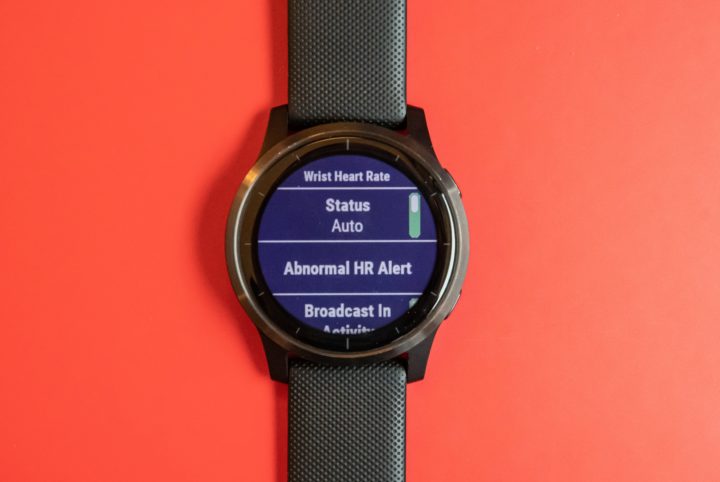
Next up we’ve got heart rate accuracy. This roughly falls into two buckets: 24×7 HR, and workout HR. As is usually the case with most devices these days, I see no tangible issues with 24×7 HR. It works well across both normal daily routines as well as things like sleep. Speaking of which, I talk about RHR values and 24×7 monitoring here and why it’s interesting.
Before we move on to the test results, note that optical HR sensor accuracy is rather varied from individual to individual. Aspects such as skin color, hair density, and position can impact accuracy. Position, and how the band is worn, are *the most important* pieces. A unit with an optical HR sensor should be snug. It doesn’t need to leave marks, but you shouldn’t be able to slide a finger under the band (at least during workouts). You can wear it a tiny bit looser the rest of the day.
Ok, so in my testing, I simply use the watch throughout my normal workouts. Those workouts include a wide variety of intensities and conditions, making them great for accuracy testing. I’ve got steady runs, interval workouts on both bike and running, as well as swimming – though, I didn’t focus on optical HR accuracy there.
For each test, I’m wearing additional devices, usually 3-4 in total, which capture data from other sensors. Typically I’d wear a chest strap (usually the Garmin HRM-DUAL or Wahoo TICKR X, but also recently the Polar H9) as well as another optical HR sensor watch on the other wrist (lately the Polar OH1 Plus, as well as the new Mio Pod). Note that the numbers you see in the upper right corner are *not* the averages, but rather just the exact point my mouse is sitting over. Note all this data is analyzed using the DCR Analyzer, details here.
We’re going to start with something simple here first – a relatively straightforward 5KM run with not a lot of variability. This is compared against an HRM-DUAL chest strap, a Polar OH1 optical HR sensor, and the Polar Vantage V optical sensor. Here’s that data set:
As you can see above, for the most part it’s pretty close. However, the first 4 minutes is accented with a number of offsets. Initially you’ve got a bit of a slower ramp from the Vivoactive 4. That’s not unusual, and is really only lag of a few seconds. However around the 90-second marker we see some splitting again, going a bit lower, which is shown more dramatically at the 4-minute marker being about 10BPM low.
It however corrects itself and is perfectly fine the rest of the run.
And again, while I dislike averages, you can see that the earlier differences had negligible impact on the run averages (Note the FR945 is showing the HRM-DUAL chest strap data):
So let’s make things more difficult. Straight up outdoor track intervals. No need to mess around here, let’s go for broke. Here’s that data set, compared against an Apple Watch Series 5 and Polar H9 chest strap:
This workout shows approximately a 14-minute warm-up/build, followed by 5x800m and then 4x200m intervals. The Vivoactive 4 is in purple, and as you can see, it’s actually pretty darn good for the most part. Not perfect, but likely more than acceptable in most people’s minds.
Let’s look at the 800m intervals specifically more closely:
Here we see that while very close, there is a bit of separation between the Vivoactive 4 during the build and recovery of each hard effort. It’s not much, and you’d likely never notice it out on a track without comparative data. Essentially, it’s lagging by a couple of seconds. In the first interval it lagged by slightly more than I would accept, however for all the remaining intervals we’re only talking a few seconds of difference. This is actually a pretty good result for Garmin’s Elevate sensor. Also, we see that virtually all of the early Apple Watch Series 5 teething pains with their optical HR sensor are gone now.
Next there’s the 200m intervals. Well, technically they were 30-second sprints. Either way, the pace for these is about 5:00/mile, so cookin’ along. There’s 90 seconds of recovery between each one. In this case you’re mostly seeing the HR catch-up towards the end of each interval. That’s just normal for how your body reacts to this. Still, what we see here is that the Vivoactive 4 did the first one fine (build), but then struggled on the 2nd one quit a bit. The third one also has significant lag, but the 4th interval is pretty much spot on.
It’s almost as if the Vivoactive 4 was…err…warming-up. Still, in this scenario nobody is using heart rate to pace 30-second intervals. It’s just not practical due to HR as an indicator lagging given the shortness of it. So this is more about post-run analytics.
Next, let’s look at an indoor bike workout. I’ve done a lot of indoor bike workouts over the last two months. And the trend I see tends to be about 80% of the time aligned to this first result, and about 20% of the time aligned to the second result. Here’s the first indoor bike example:
As you can see, the Vivoactive 4 is drunk. Yes, it’s roughly on the same ‘highway’, but it’s all over the place. Totally loses the plot. And for this workout I’m not doing anything crazy – I’m just pedaling. This is a pattern I’ve repeatedly seen with the Vivoactive 4 on indoor cycling workouts, and is honestly unlike anything I’ve seen from Garmin previously. To validate these I’ve even got two totally different units sourced on two totally different continents months apart – both show the same patterns.
However, about 20% of the time I get something like below, which is better but not great. This workout was separated just two days from the above workout and on the exact same watch. There’s only the Polar H9 shown here as a secondary example, but that’s good enough to see that it’s better than above – though still wobbly:
And again, another indoor bike workout with a crapton of different sensors, and only the Vivoactive 4 was drunk:
So what about outside cycling? Glad you asked, here’s that data set:
This was down in Australia on a ‘fun’ ride up into the hills/mountains and back again. You can see how the first 2/3rds has higher heart rates as we climb and pedal harder, then a short break at the top to check out the view, followed by lower heart rates as we descend. The purple of the Vivoactive 4 seems to stick out the most above, showing you where it’s offset from others. But let’s zoom in to a few of the climbing portions:
You can see above that, for the most part, the different sensors are fairly close. However, there are a few drops around the 1:02 marker where the Vivoactive 4 is considerably off-beat from the rest. That massive climb in HR to 185 or so is when the grade painfully goes to 20% (on a road bike). It sucked. I suspect those two dips are when I’m holding tighter on the handlebars and that causes strain for the optical HR sensor. Whereas other climbing portions are mostly fine, albeit still with some little spikes on the Vivoactive (drops more accurately):
As for descending, the Vivoactive 4 was a solid mess there. The Polar Vantage V was roughly in the ballpark with the Garmin HRM-DUAL and MioPod sensors, but the Vivoactive 4 basically flat-lined and gave up on life:
This isn’t super unusual per se for wrist-based sensors during vibration-laden descents, but again, the Polar sensor here had no issues on my other wrist.
So ultimately, the Vivoactive 4 optical HR accuracy seems a bit mixed. On easier scenarios (which is any form of indoor cycling) it seems to fumble the most. Heck, even during some running warm-ups it fumbles a bit. Yet for harder scenarios like the 800m intervals, it actually does fairly well, which matches what I saw with other track workouts too. For outdoor cycling, it shows the occasional dips/spikes that we see indoors, albeit at less frequency. It did have trouble descending.
So again, like GPS, you’ll have to decide whether it fits your requirements or not. If you’re just looking for ballpark accuracy, for running it seemed mostly OK there. Whereas for cycling it struggled more than I typically see for Garmin’s Elevate sensor.
Product Comparison:
I’ve added the Garmin Vivoactive 4 into the product comparison database, allowing you to compare it against other products that I’ve reviewed in the past. For the purposes of below I’ve compared it against the Apple Watch Series 5, Fitbit Ionic, and Samsung Galaxy Active Watch 2 – which are the ones most people will be comparing it against from a sports/fitness standpoint.
Note that with all these watches – but especially the Apple Watch, there are many cases below where “with 3rd party apps” can be used. The same is largely true of Garmin, Samsung, and somewhat with Fitbit. But the Apple Watch tends to offload more core fitness functionality to 3rd party apps than the others. I’ve tried to thread the needle of apps that I roughly know exist where I’ve listed that. But it’s not perfection in terms of knowing every app on earth. Ultimately, I don’t think any consumer does (or should). Plus, we’ve actually seen a pulling back of wearable apps from companies over the last year (basically, they stop updating them). Making it even harder to know an up to date app from a dysfunctional one dying on the vine.
Finally, I didn’t add the Garmin Venu into this set, because honestly the features as seen below are identical between the Vivoactive & Venu, save the differences in battery life due to the differences in display. So, here’s my two-second thoughts on the display differences:
The Garmin Venu display is by far the best display Garmin has made to date. It’s not Apple Watch level display, but it looks really damn good. After three months of daily Garmin Venu wearing, I ‘went down’ to the Vivoactive 4 for these last few months. And I’ll readily admit the first day it was like ‘Ugh.’ But after that first day, it became the new normal and didn’t bother me. And in fact, without a Venu display side by side, it seems quite nice to me. Plus, I get more days battery out of it – which is handy.
Ok, onto the full chart:
| Function/Feature | Apple Watch Series 5 | Fitbit Ionic | Garmin Vivoactive 4 | Samsung Galaxy Active |
|---|---|---|---|---|
| Copyright DC Rainmaker - Updated October 18th, 2023 @ 10:11 am New Window | ||||
| Price | $399/$499 (cellular) | $229 | $299 | $199 |
| Product Announcement Date | Sept 10th, 2019 | Aug 28th, 2017 | Sept 5th, 2019 | Feb 20th, 2019 |
| Actual Availability/Shipping Date | Sept 20st, 2019 | Oct 1st, 2017 | Sept 5th, 2019 | Mar 9th, 2019 |
| GPS Recording Functionality | Yes | Yes | Yes | Yes |
| Data Transfer | Bluetooth Smart | Bluetooth Smart | USB, BLUETOOTH SMART, WiFi | Bluetooth Smart |
| Waterproofing | 50m | 50m | 50 meters | 50 meters |
| Battery Life (GPS) | 6hrs GPS on time (18hrs standby) | 10 hours | 18 hours GPS | Undeclared (claims 45hrs non-GPS) |
| Recording Interval | Varies | 1-second | 1s or Smart Recording | 1-second for GPS, 1-minute for HR |
| Alerts | Vibration/Audio/Visual | Visual/Vibrate | Vibrate/Visual | Vibrate/Visual |
| Backlight Greatness | Great | Great | Great | Great |
| Ability to download custom apps to unit/device | Yes | Yes | Yes | Yes |
| Acts as daily activity monitor (steps, etc...) | Yes | Yes | Yes | YEs | Music | Apple Watch Series 5 | Fitbit Ionic | Garmin Vivoactive 4 | Samsung Galaxy Active |
| Can control phone music | Yes | Yes | Yes | Yes |
| Has music storage and playback | Yes | Yes | Yes | Yes |
| Streaming Services | Apple Music | Pandora, Deezer | Spotify, Amazon Music, Deezer | Spotify | Payments | Apple Watch Series 5 | Fitbit Ionic | Garmin Vivoactive 4 | Samsung Galaxy Active |
| Contactless-NFC Payments | Yes | Yes | Yes | Yes (but only with Samsung phone) | Connectivity | Apple Watch Series 5 | Fitbit Ionic | Garmin Vivoactive 4 | Samsung Galaxy Active |
| Bluetooth Smart to Phone Uploading | Yes | Yes | Yes | Yes |
| Phone Notifications to unit (i.e. texts/calls/etc...) | Yes | Yes | Yes | Yes |
| Live Tracking (streaming location to website) | With 3rd party apps | No | Yes | No |
| Group tracking | No | No | No | No |
| Emergency/SOS Message Notification (from watch to contacts) | Yes | No | Yes | No |
| Built-in cellular chip (no phone required) | Yes (with cellular version) | No | No | No | Cycling | Apple Watch Series 5 | Fitbit Ionic | Garmin Vivoactive 4 | Samsung Galaxy Active |
| Designed for cycling | Yes | Yes | Yes | Yes |
| Power Meter Capable | No | No | With some Connect IQ apps | No |
| Speed/Cadence Sensor Capable | No | No | Yes | No |
| Strava segments live on device | No | No | No | No |
| Crash detection | Yes via 'Fall Detection' | No | Yes | No | Running | Apple Watch Series 5 | Fitbit Ionic | Garmin Vivoactive 4 | Samsung Galaxy Active |
| Designed for running | Yes | Yes | Yes | Yes |
| Footpod Capable (For treadmills) | With 3rd party apps | No (but has treadmill functionality) | Yes | With 3rd party apps |
| Running Dynamics (vertical oscillation, ground contact time, etc...) | No | No | No | No |
| Running Power | With 3rd party apps | No | No | No |
| VO2Max Estimation | Yes | Yes via app | Yes | No |
| Race Predictor | No | No | No | No |
| Recovery Advisor | No | No | No | No |
| Run/Walk Mode | With 3rd party apps | No | Yes | With 3rd party apps | Swimming | Apple Watch Series 5 | Fitbit Ionic | Garmin Vivoactive 4 | Samsung Galaxy Active |
| Designed for swimming | Yes | Yes | Yes | Yes |
| Openwater swimming mode | YEs | No | No | Yes |
| Lap/Indoor Distance Tracking | Yes | Yes | Yes | Yes |
| Record HR underwater | Yes | No | Yes | Yes |
| Openwater Metrics (Stroke/etc.) | Basic stroke type only | No | No | No |
| Indoor Metrics (Stroke/etc.) | Basic stroke type only | Yes | Yes | Yes |
| Indoor Drill Mode | No | No | No | No |
| Indoor auto-pause feature | Yes | No | No | No |
| Change pool size | Yes | Yes | Yes | Yes |
| Indoor Min/Max Pool Lengths | 1y/m to 1,500y/m+ | 10m/y-100m/y | 13M/15Y TO 150Y/M | |
| Ability to customize data fields | Very limited | Yes | Yes | |
| Captures per length data - indoors | Yes | Yes | Yes | |
| Indoor Alerts | Yes (goals) | Yes (distance) | Yes | No | Triathlon | Apple Watch Series 5 | Fitbit Ionic | Garmin Vivoactive 4 | Samsung Galaxy Active |
| Designed for triathlon | Not really | No | No | No |
| Multisport mode | Yes | No | No | Sorta (can combine sports manually) | Workouts | Apple Watch Series 5 | Fitbit Ionic | Garmin Vivoactive 4 | Samsung Galaxy Active |
| Create/Follow custom workouts | With 3rd party apps | No (Premium Coached only) | Yes | No |
| On-unit interval Feature | With 3rd party apps | No | Sorta | No |
| Training Calendar Functionality | With 3rd party apps | No | Yes | No | Functions | Apple Watch Series 5 | Fitbit Ionic | Garmin Vivoactive 4 | Samsung Galaxy Active |
| Auto Start/Stop | Yes | Yes | Yes | Yes |
| Virtual Partner Feature | Sorta (Pacing feature) | No | No | Pace guidance only |
| Virtual Racer Feature | No | No | No | No |
| Records PR's - Personal Records (diff than history) | No | No | Yes | No |
| Tidal Tables (Tide Information) | No | No | No | No |
| Weather Display (live data) | Yes | Yes | Yes | Yes | Navigate | Apple Watch Series 5 | Fitbit Ionic | Garmin Vivoactive 4 | Samsung Galaxy Active |
| Follow GPS Track (Courses/Waypoints) | With 3rd party apps | No | No (but some 3rd party apps can) | No |
| Markers/Waypoint Direction | With 3rd party apps | No | No | No |
| Routable/Visual Maps (like car GPS) | With 3rd party apps | No | No | No |
| Back to start | With 3rd party apps | No | YEs | No |
| Impromptu Round Trip Route Creation | With 3rd party apps | No | No | No |
| Download courses/routes from phone to unit | With 3rd party apps | No | NO | 3rd party apps | Sensors | Apple Watch Series 5 | Fitbit Ionic | Garmin Vivoactive 4 | Samsung Galaxy Active |
| Altimeter Type | Barometric | Barometric | Barometric | Barometric |
| Compass Type | Magnetic | N/A | Magnetic | N/A |
| Optical Heart Rate Sensor internally | Yes | Yes | Yes | Yes |
| SpO2 (aka Pulse Oximetry) | No | Yes | No | |
| Heart Rate Strap Compatible | Yes | No | Yes | 3rd Party Apps only |
| ANT+ Heart Rate Strap Capable | No | No | YEs | No |
| ANT+ Speed/Cadence Capable | no | No | Yes | No |
| ANT+ Footpod Capable | No | No | Yes | No |
| ANT+ Power Meter Capable | No | No | No | no |
| ANT+ Lighting Control | No | No | Yes | no |
| ANT+ Bike Radar Integration | No | No | Yes | No |
| ANT+ Trainer Control (FE-C) | No | No | No | No |
| ANT+ Remote Control | No | No | No (Yes for VIRB camera control) | No |
| ANT+ eBike Compatibility | No | No | No | No |
| ANT+ Gear Shifting (i.e. SRAM ETAP) | No | No | No | nO |
| Shimano Di2 Shifting | No | No | No | No |
| Bluetooth Smart HR Strap Capable | Yes | No | YEs | 3rd party apps only |
| Bluetooth Smart Speed/Cadence Capable | No | No | Yes | No |
| Bluetooth Smart Footpod Capable | No | No | Yes | 3rd party apps only |
| Bluetooth Smart Power Meter Capable | No | No | No | No |
| Temp Recording (internal sensor) | No | No | No | Yes |
| Temp Recording (external sensor) | No | No | Yes | No | Software | Apple Watch Series 5 | Fitbit Ionic | Garmin Vivoactive 4 | Samsung Galaxy Active |
| PC Application | None | PC/Mac | Garmin Express | No |
| Web Application | None | Yes | Garmin Connect | No |
| Phone App | iOS only | iOS/Android/Windows | iOS/Android/Windows | iOS/Android (iOS is limited though) |
| Ability to Export Settings | No | No | No | No | Purchase | Apple Watch Series 5 | Fitbit Ionic | Garmin Vivoactive 4 | Samsung Galaxy Active |
| Amazon | Link | Link | Link | Link |
| Backcountry.com | Link | |||
| Competitive Cyclist | Link | |||
| REI | Link | Link | DCRainmaker | Apple Watch Series 5 | Fitbit Ionic | Garmin Vivoactive 4 | Samsung Galaxy Active |
| Review Link | Link | Link | Link | Link |
And again – don’t forget you can make your own product comparison charts comparing any products using the product comparison database.
Summary:
Overall the Vivoactive 4 is a solid upgrade over the Vivoactive 3, if for no other reason than the darn second button. Plus of course the music in all models and the other health bits. But really, that button. It might sound silly to those unfamiliar with sports watches, but the user interface is greatly improved when you’ve got two distinct and quick confirmation and back buttons. Many watches have this feature alongside their touch screens.
Now while the new health features are handy, I can’t imagine they’ll be a significant enough draw for existing Vivoactive 3 users. But if you’ve got an older Vivoactive, or perhaps are coming from a different watch – then they might just tip the scales. Or, perhaps it’s Spotify and Amazon Music offline support. Or just being a sport-first watch.
However, within that context it’s not perfect. I’ve found the optical HR accuracy a bit mixed. Oddly it seems to perform better in tougher conditions for me, but has oft struggled in easier conditions. For example, it handles indoor and outdoor running intervals breezily, yet fumbled over itself for relatively benign indoor spin/trainer workouts with minimal movement/intensity. For GPS, it was the same mixed bag as the heart rate was. Definitely not the best Garmin watch accuracy-wise I’ve seen in the last 12 months.
Lastly, is price. As I’ve said since the beginning – the Vivoactive 4 at $349 is overpriced compared to the competition (or even compared to Garmin), especially for less athletic focused folks where a $199 Apple Watch is probably a better all-round option. But I think Garmin sees that too. They dropped the price to $299 during the holidays, and it’s back at that again right now. To me that’s still a bit pricey but is a fair price and I suspect we’ll see it stay there.
Finally, the Vivoactive 4 feels more polished than past Garmin Vivoactive attempts. It feels less plastic-looking, primarily due to bezel design. I’ve been surprised at how many asked what the watch is (since it has no branding on it), liking the looks of it. Between the apparent looks, and the actual underlying functionality – overall it’s a solid option for a fitness/sport focused person.
Found This Post Useful? Support The Site!
Hopefully you found this review/post useful. At the end of the day, I’m an athlete just like you looking for the most detail possible on a new purchase – so my review is written from the standpoint of how I used the device. The reviews generally take a lot of hours to put together, so it’s a fair bit of work (and labor of love). As you probably noticed by looking below, I also take time to answer all the questions posted in the comments – and there’s quite a bit of detail in there as well.
If you're shopping for the Garmin Vivoactive 4 or any other accessory items, please consider using the affiliate links below! As an Amazon Associate I earn from qualifying purchases. It doesn’t cost you anything extra, but your purchases help support this website a lot.
Here's a few other variants or sibling products that are worth considering:
And finally, here’s a handy list of accessories that work well with this unit (and some that I showed in the review). Given the unit pairs with ANT+ & Bluetooth Smart sensors, you can use just about anything though.
And of course – you can always sign-up to be a DCR Supporter! That gets you an ad-free DCR, access to the DCR Quarantine Corner video series packed with behind the scenes tidbits...and it also makes you awesome. And being awesome is what it’s all about!
Thanks for reading! And as always, feel free to post comments or questions in the comments section below, I’ll be happy to try and answer them as quickly as possible. And lastly, if you felt this review was useful – I always appreciate feedback in the comments below. Thanks!





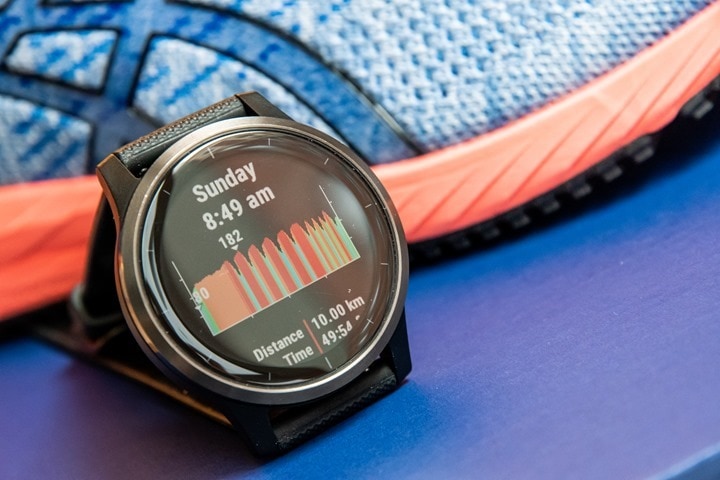
![DSC_6578_thumb[1] DSC_6578_thumb[1]](https://media.dcrainmaker.com/images/2020/02/DSC_6578_thumb1_thumb.jpg)
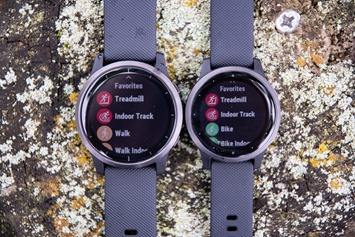
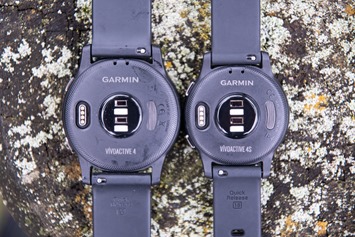
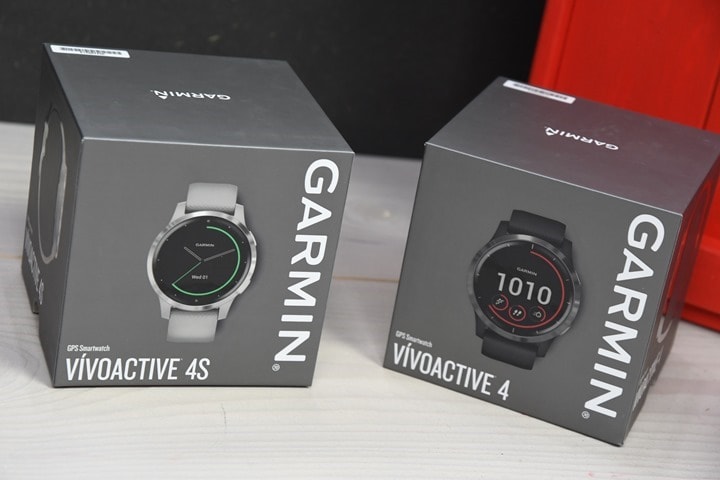
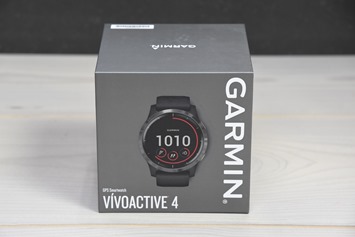

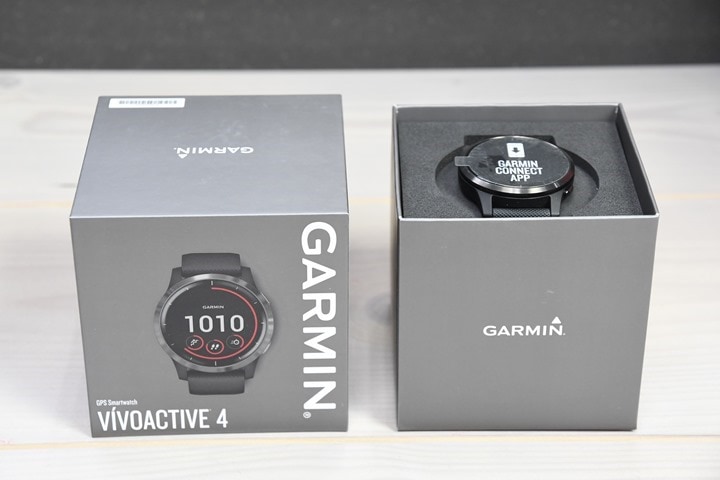
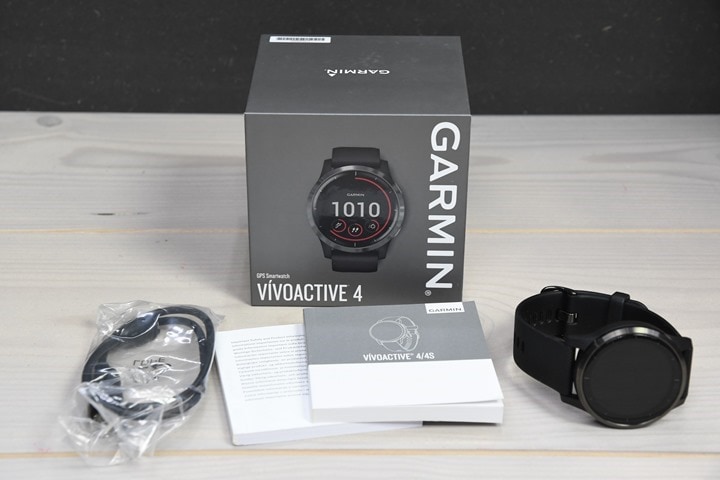
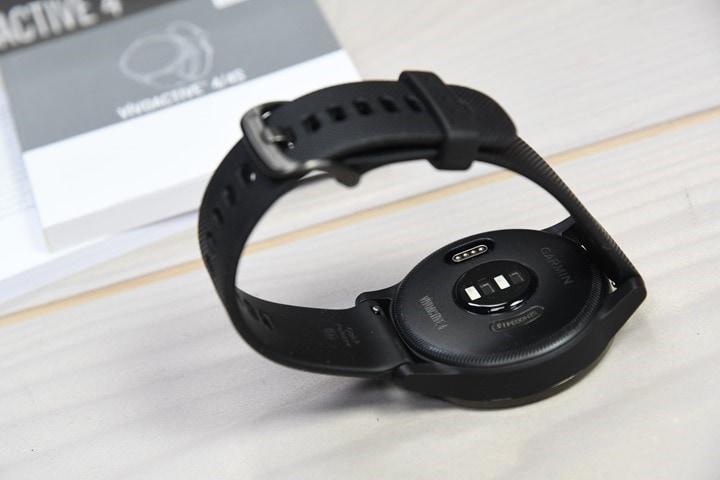
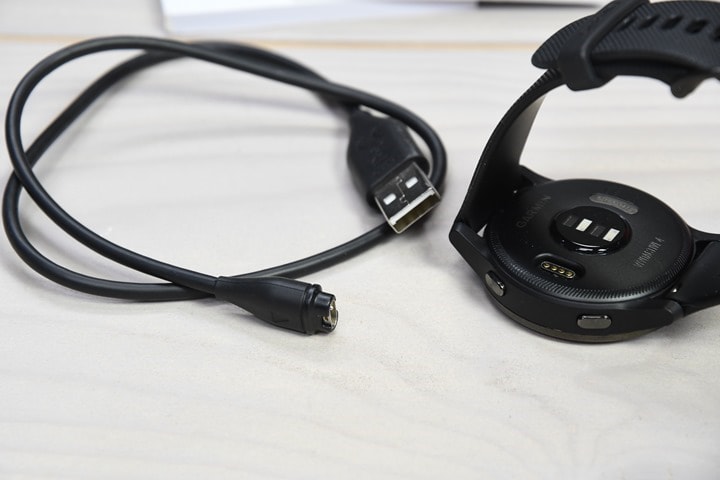
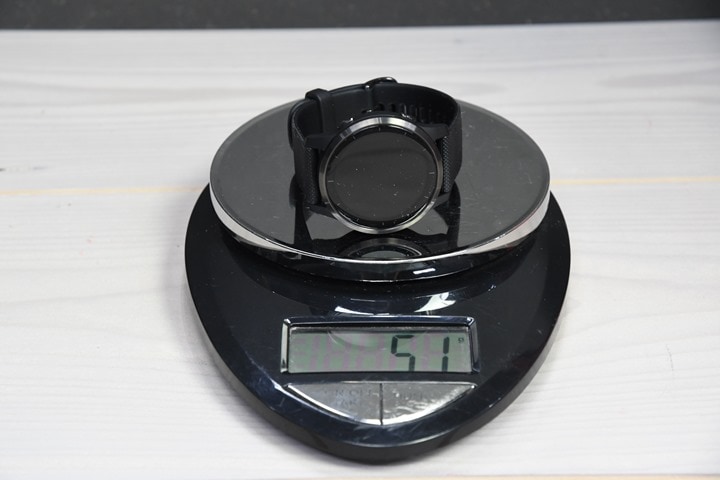

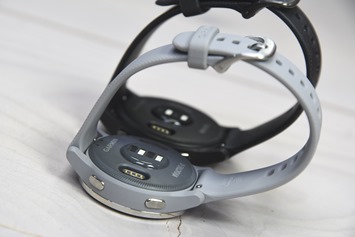
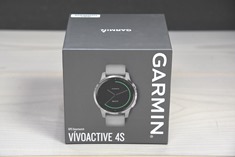
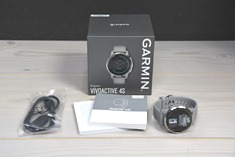
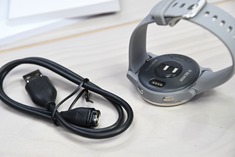
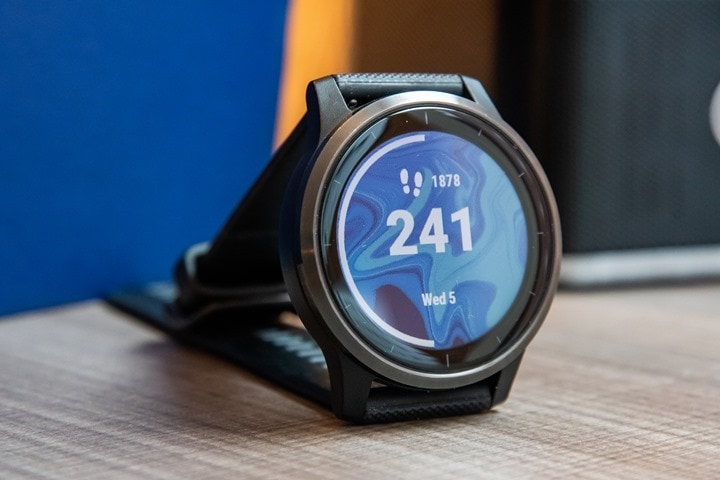
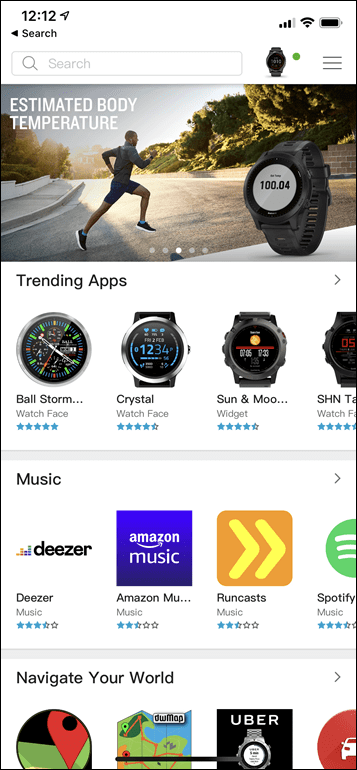
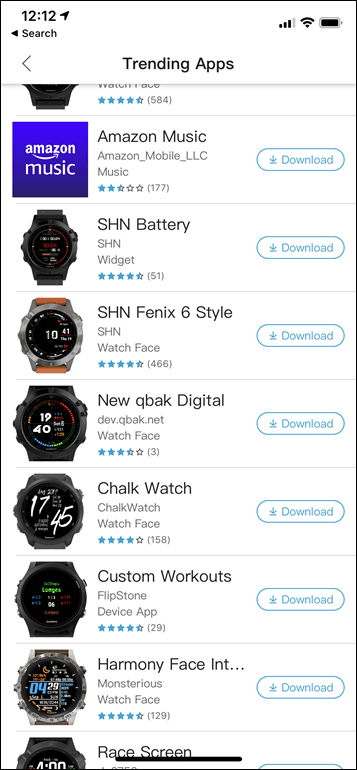
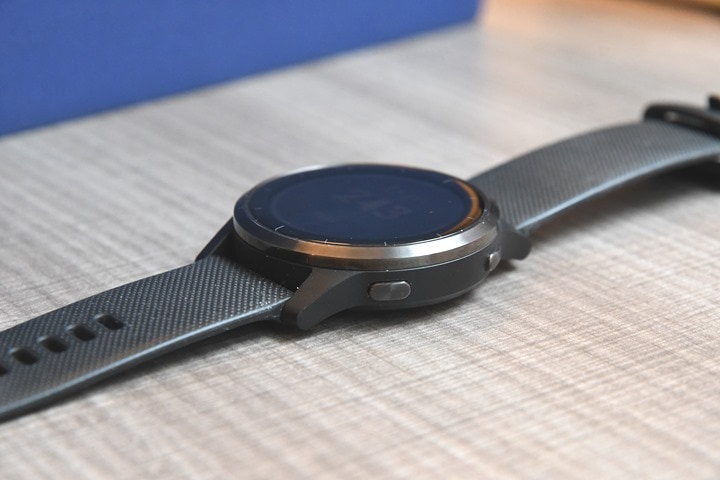
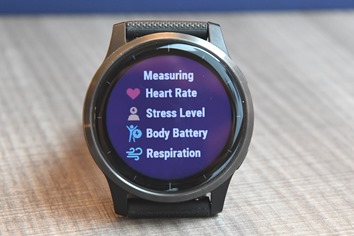
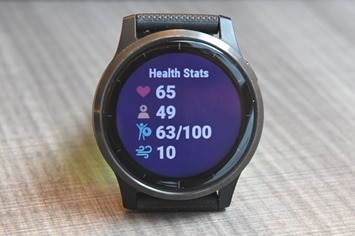
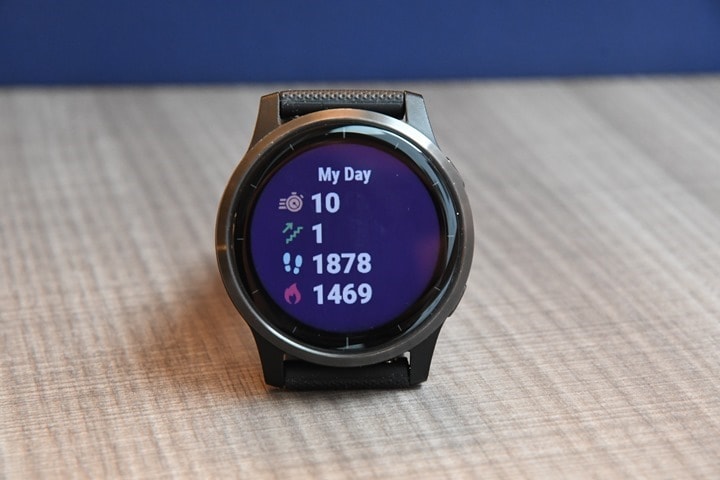
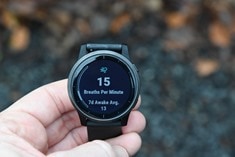
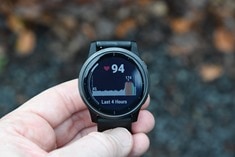
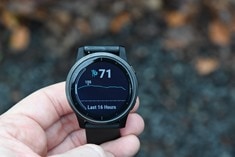
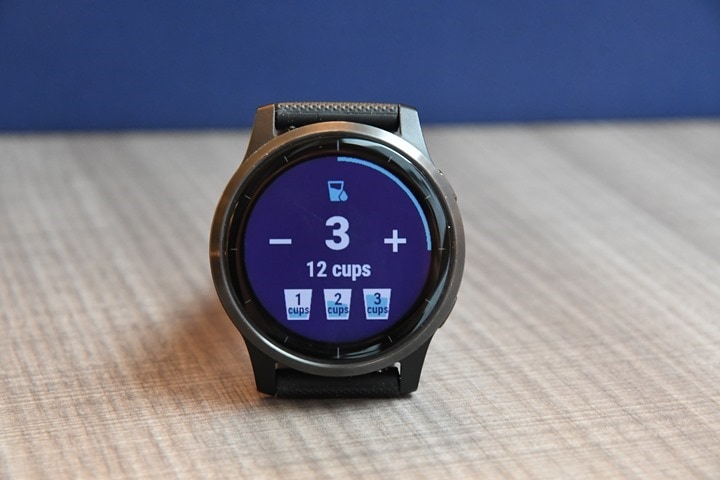
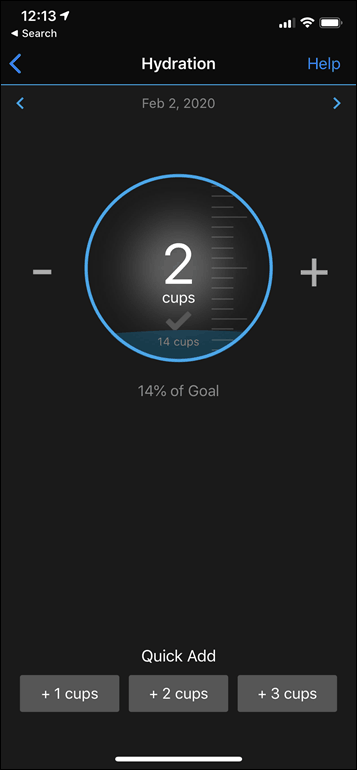
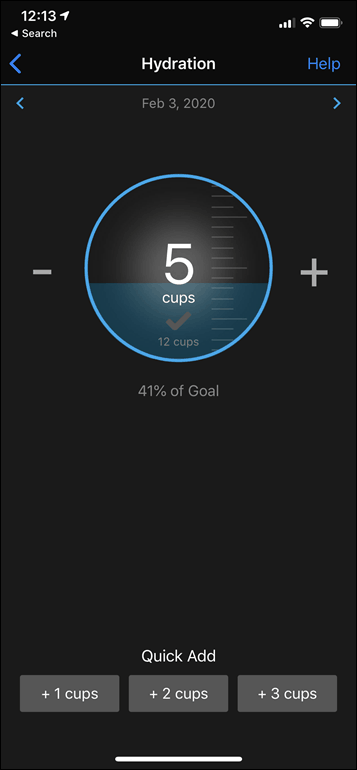
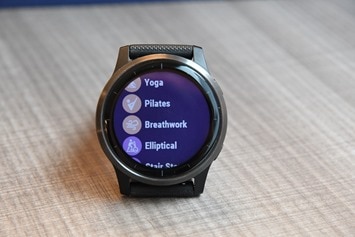
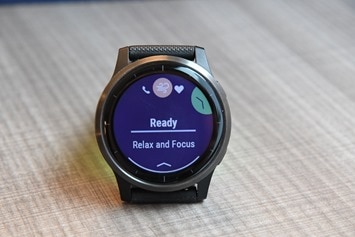
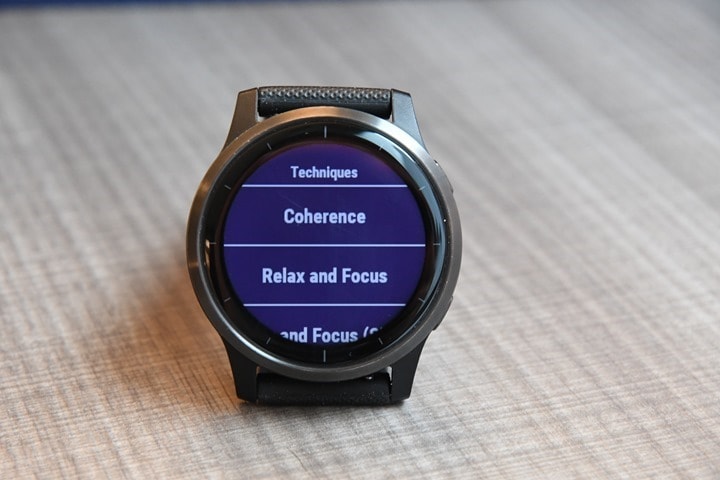




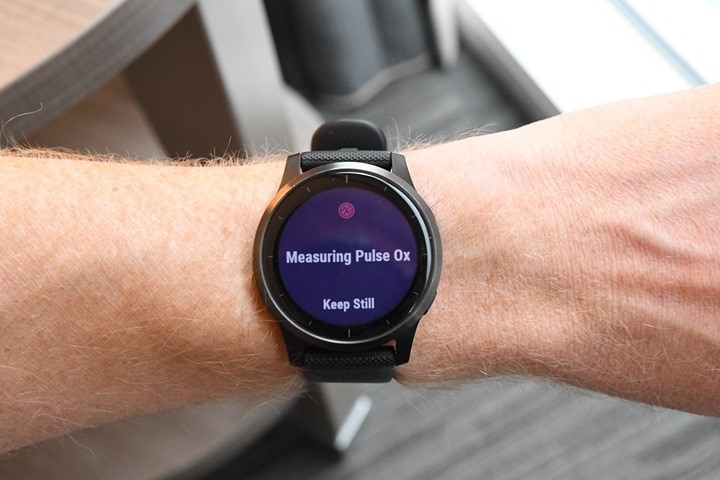

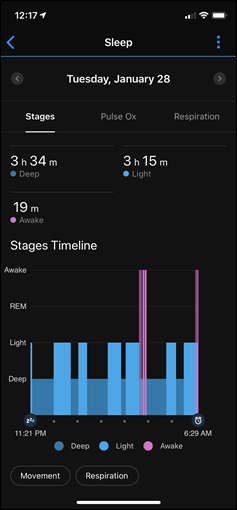
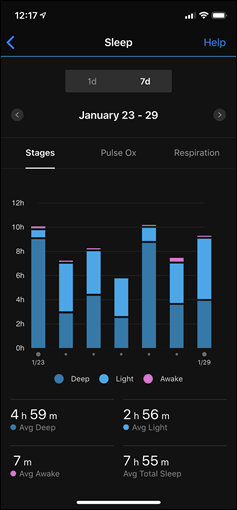
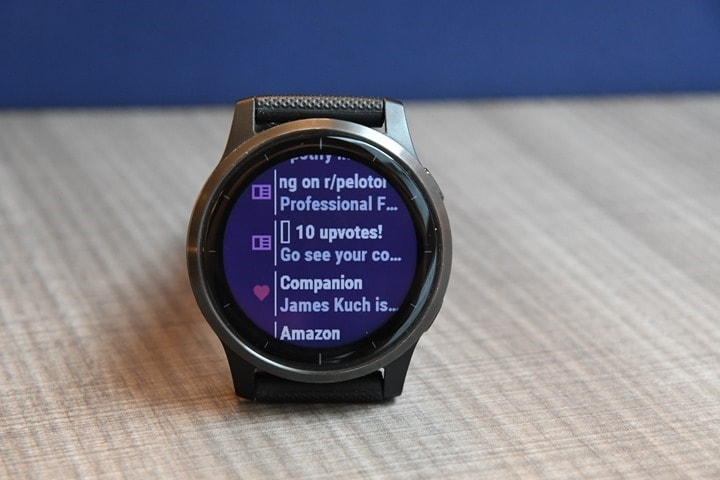
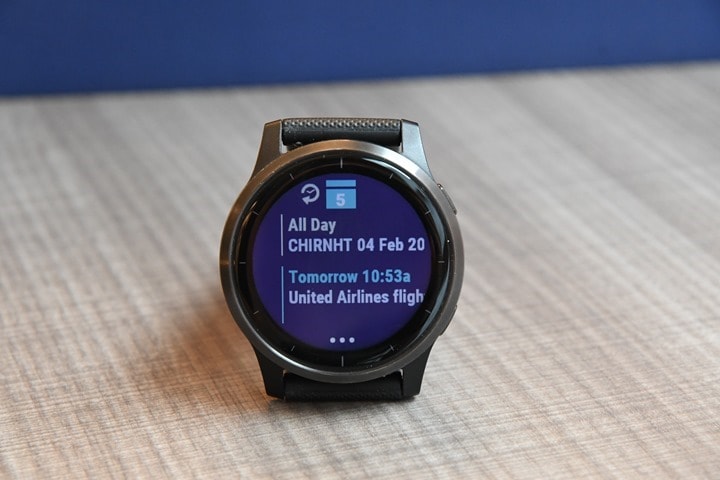
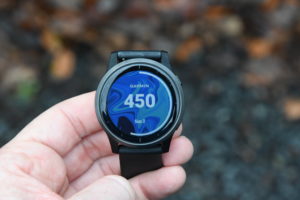
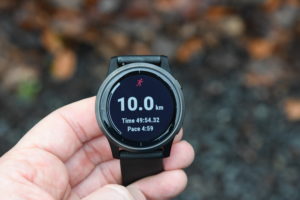
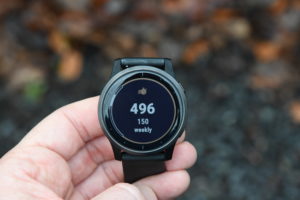
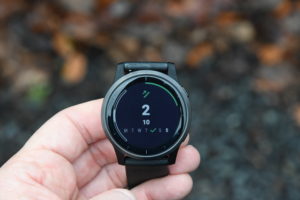
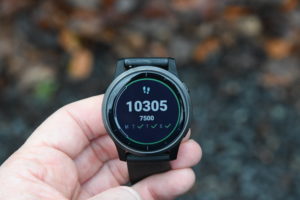
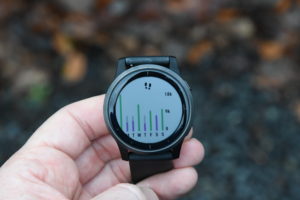
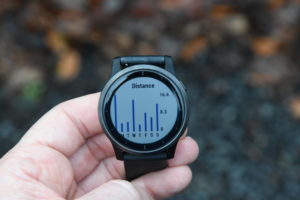
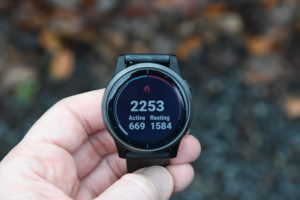
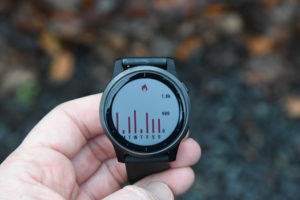
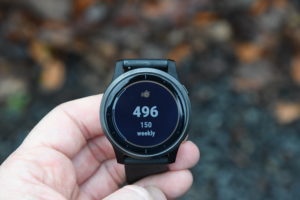
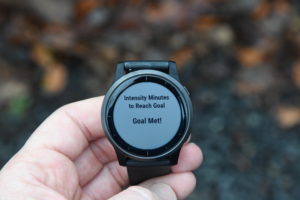
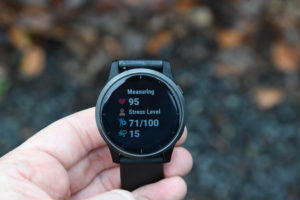
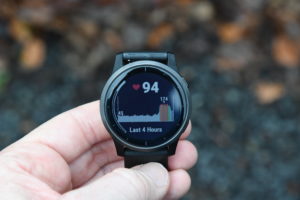

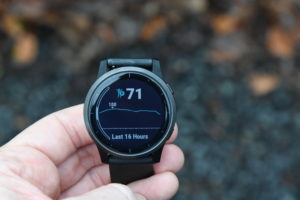
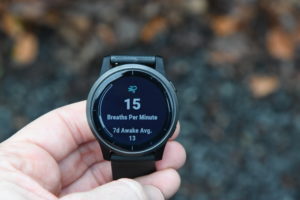
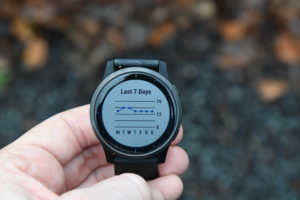
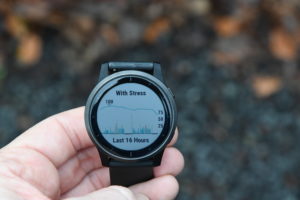
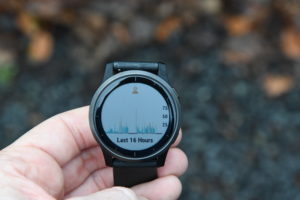

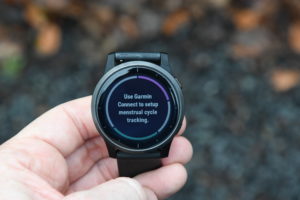
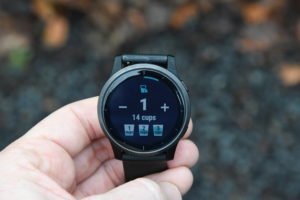

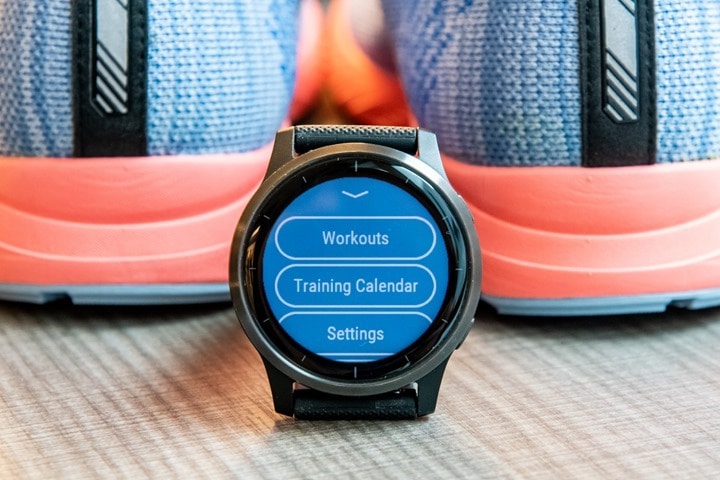
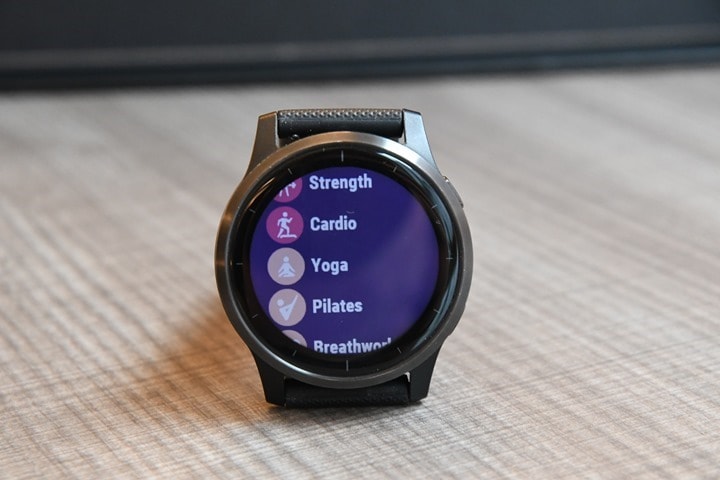
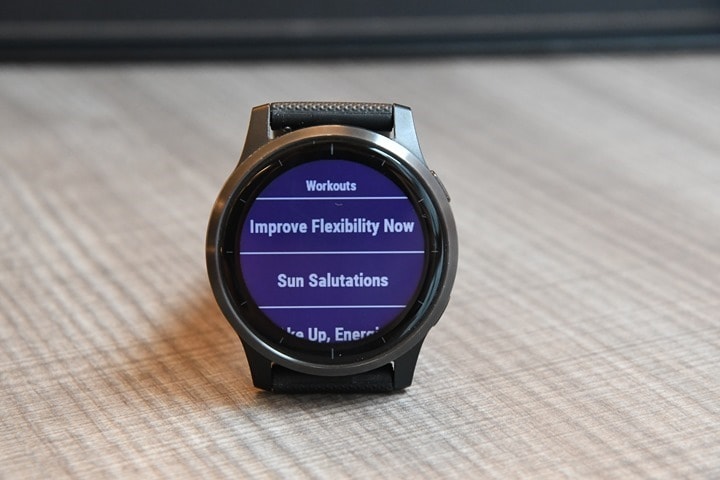
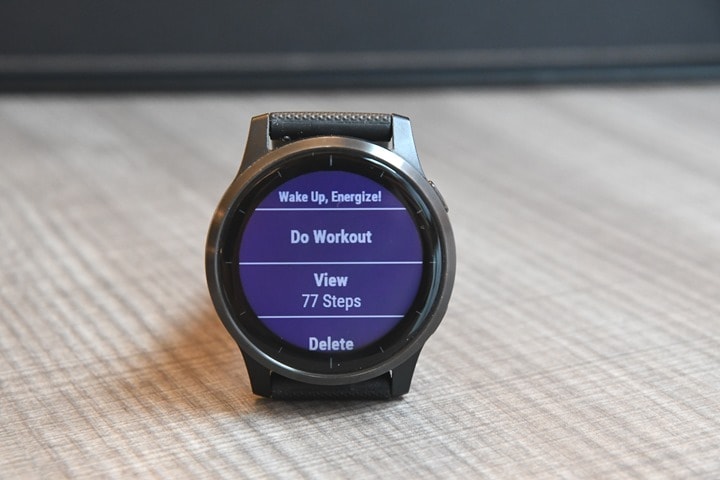
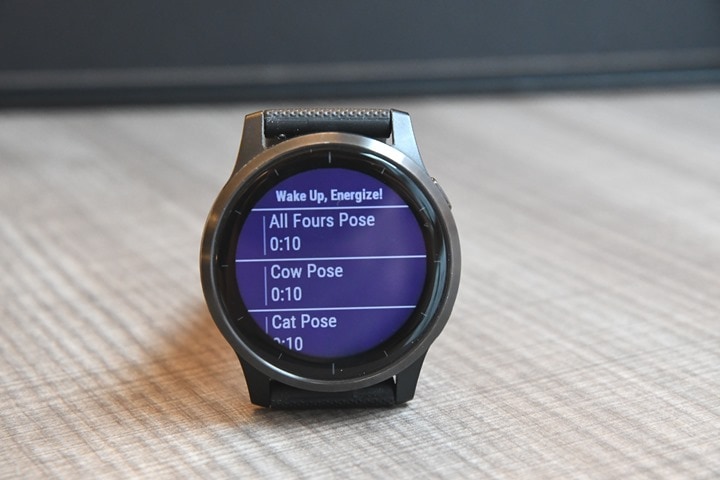
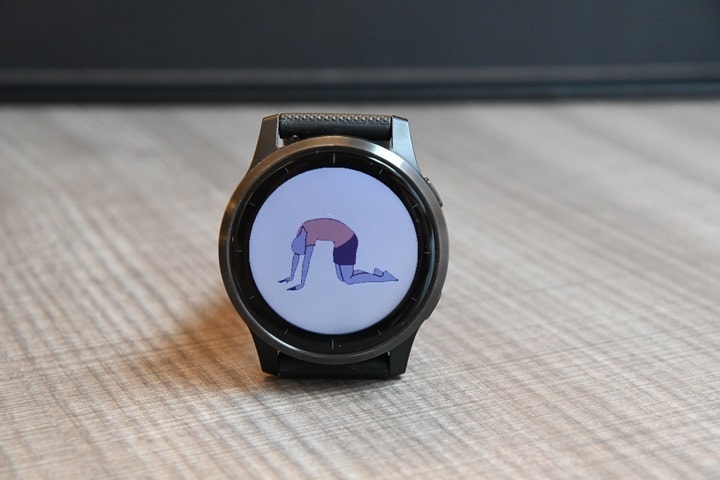
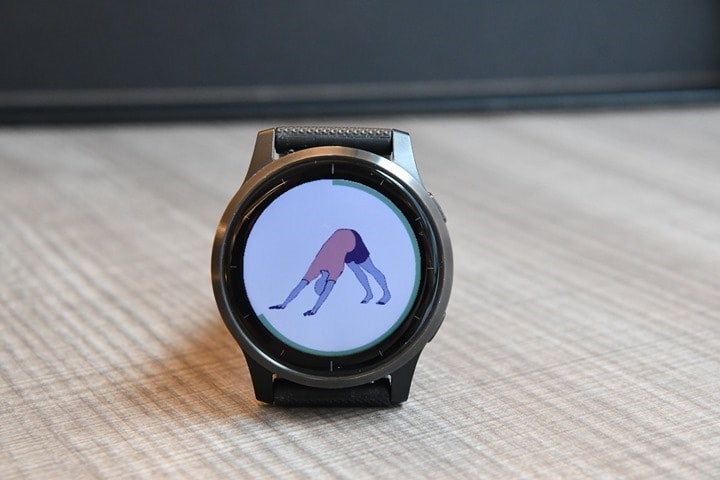
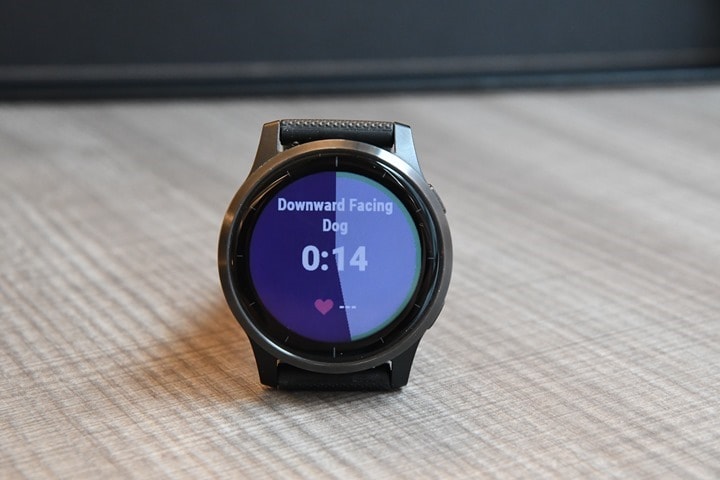
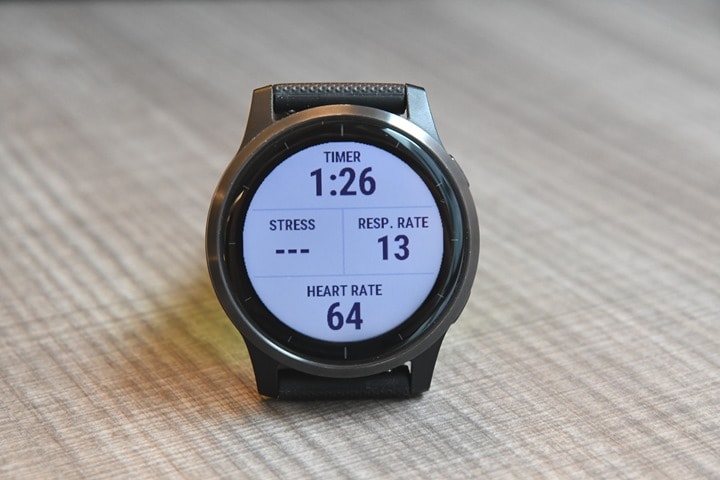
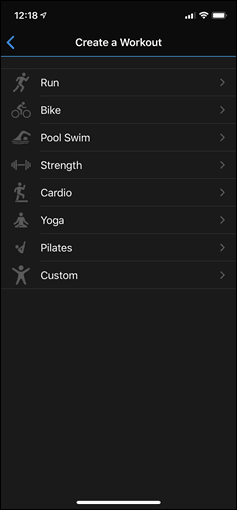
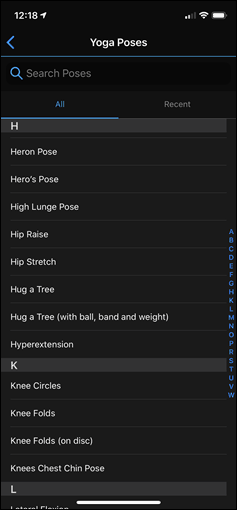
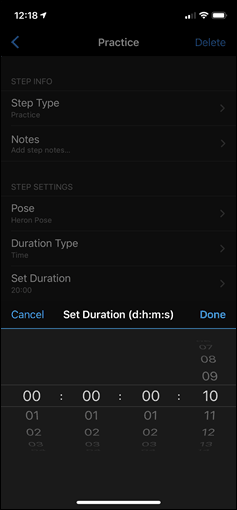
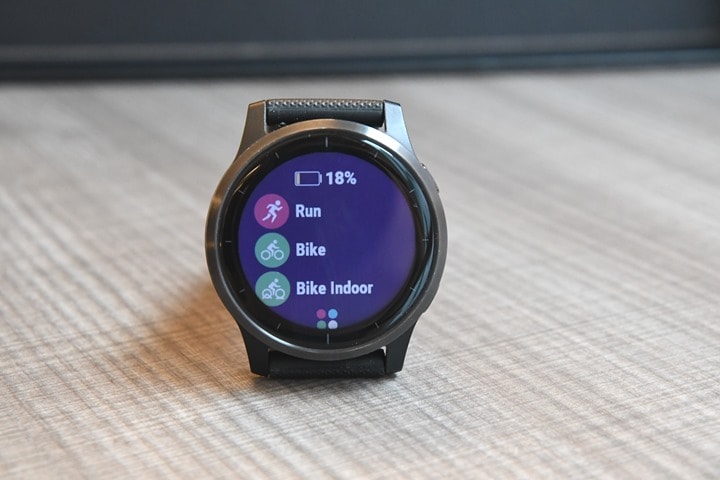
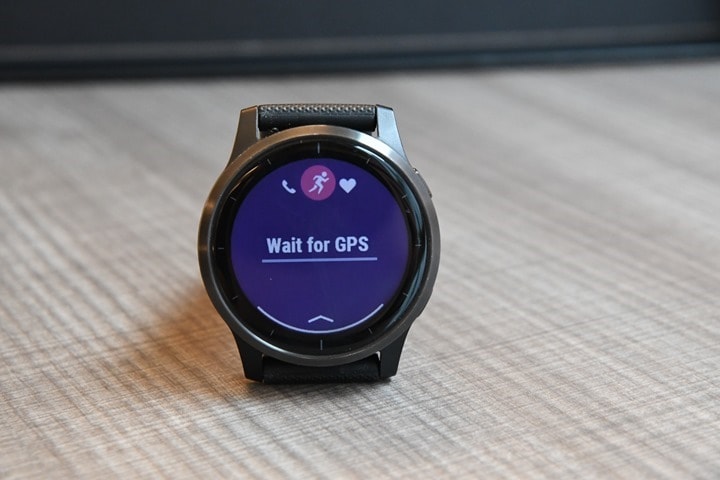
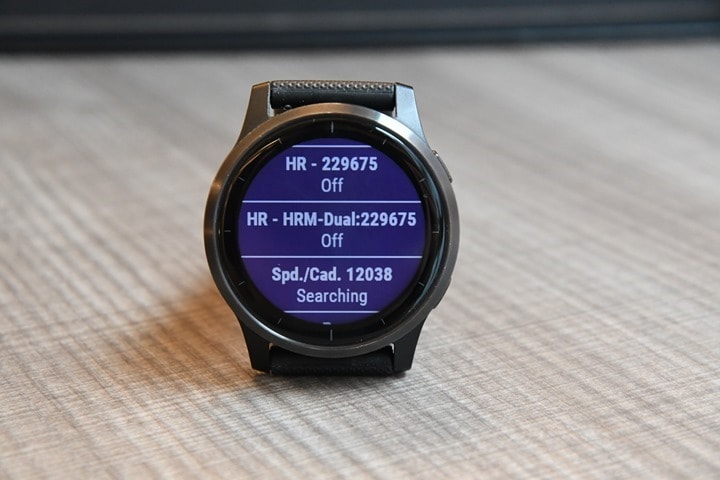
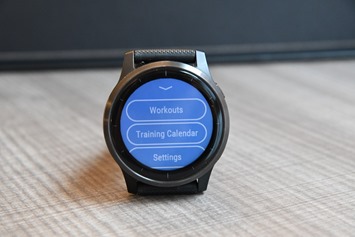

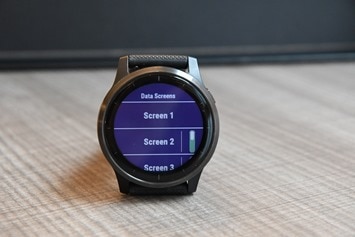


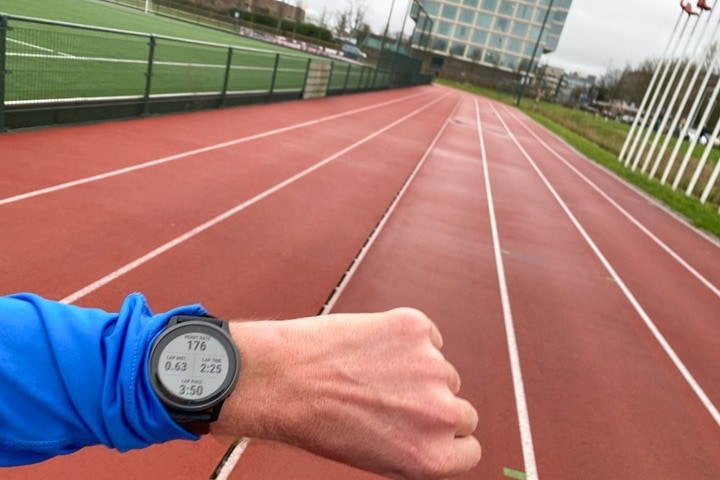
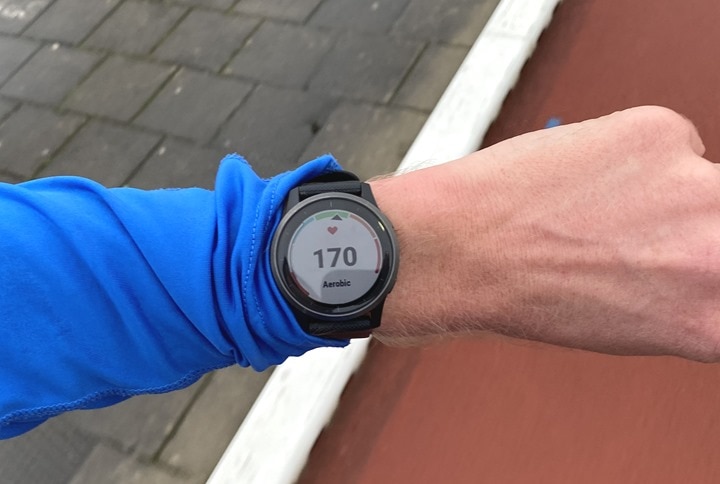

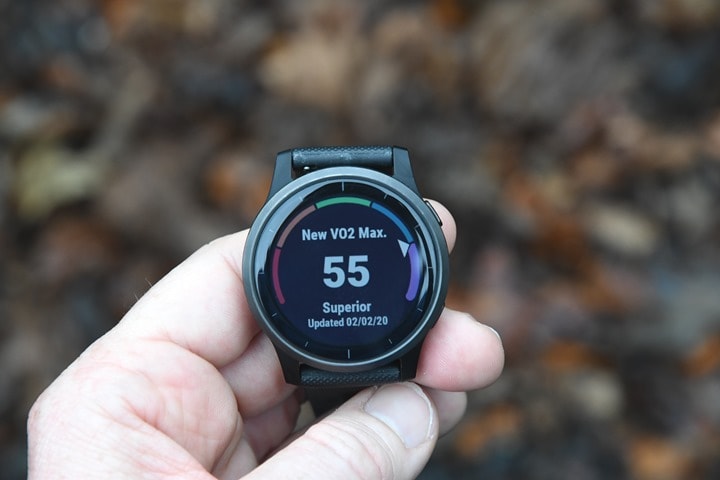

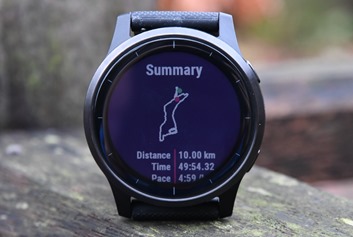
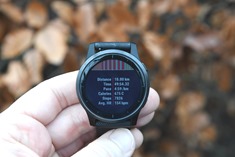
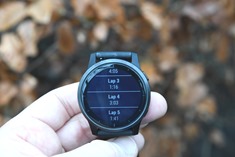

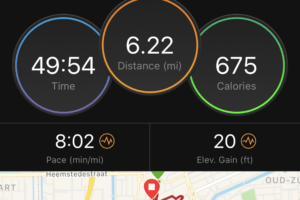
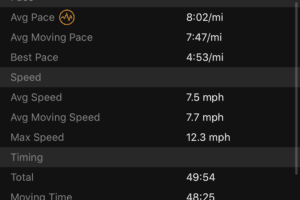
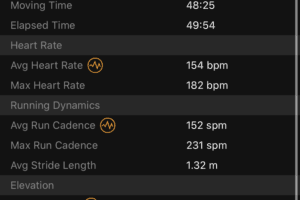
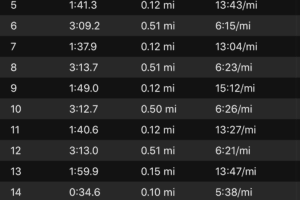
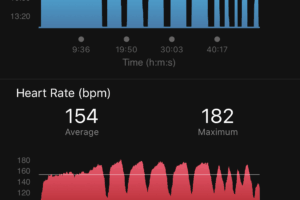
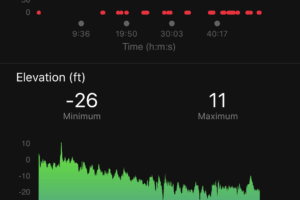



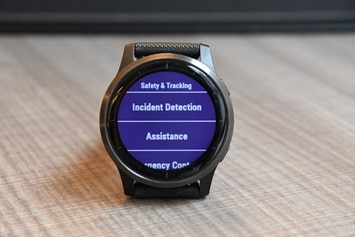
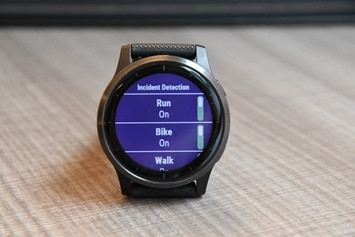

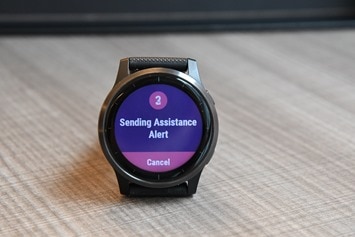
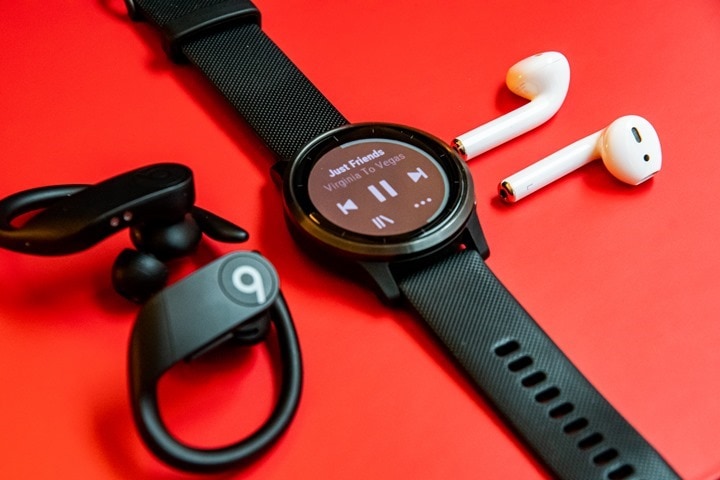
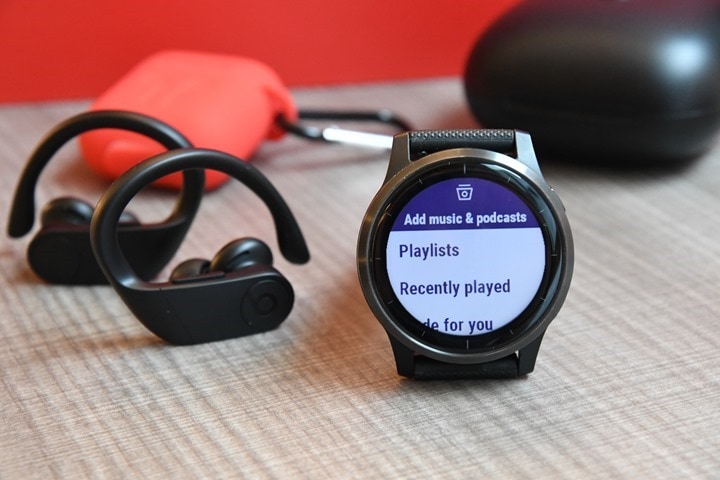
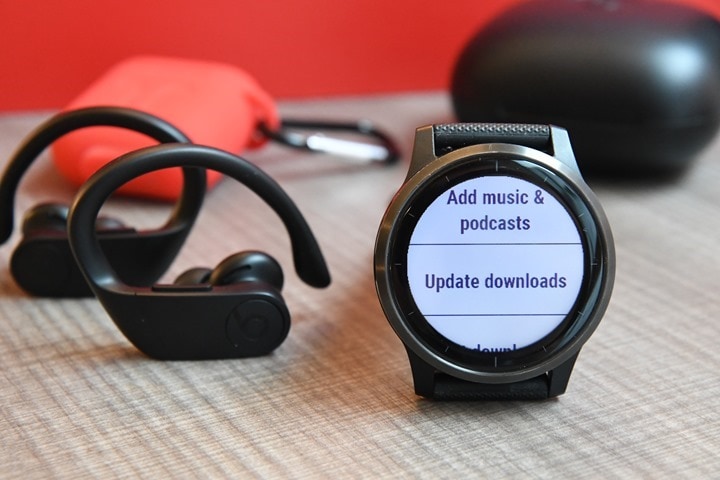
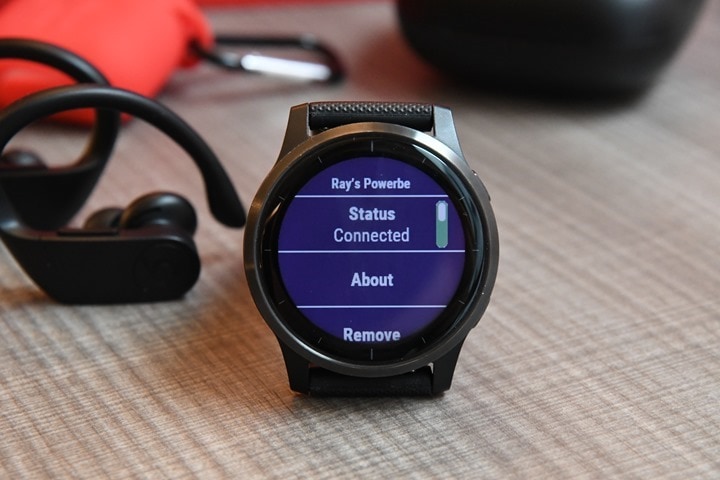
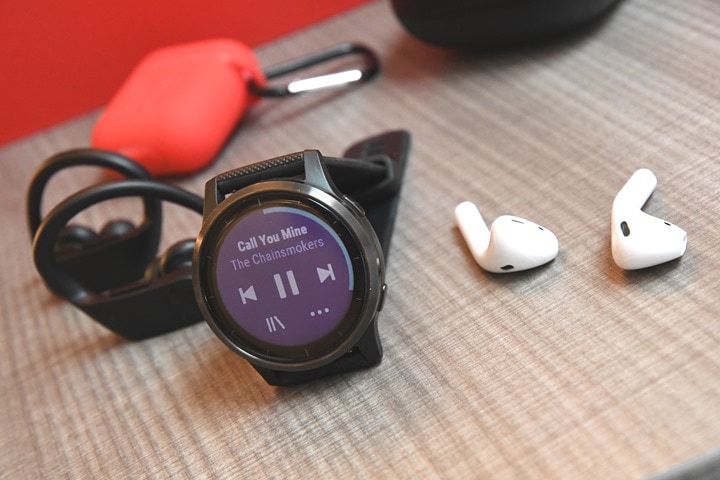



























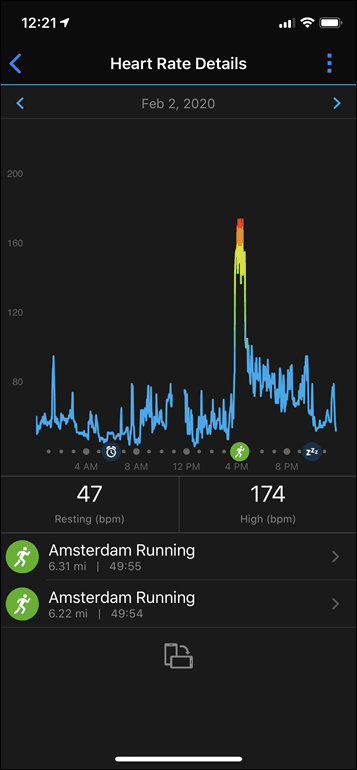
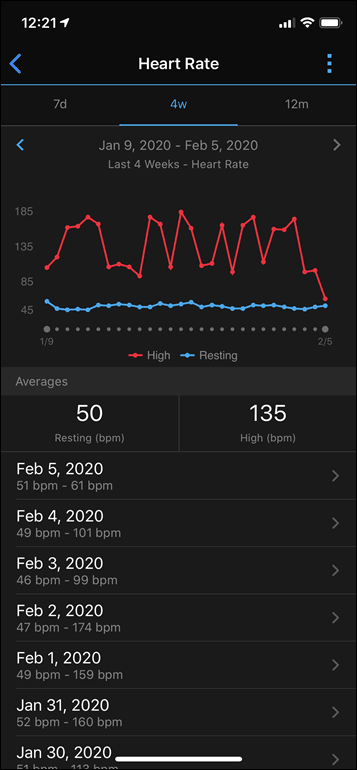














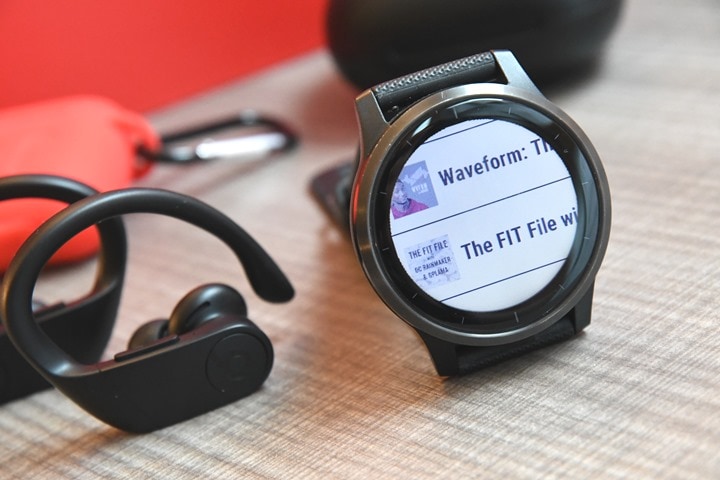
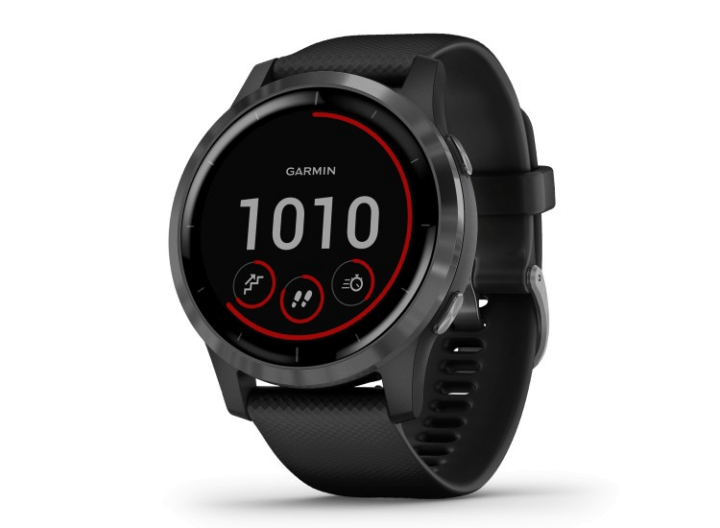
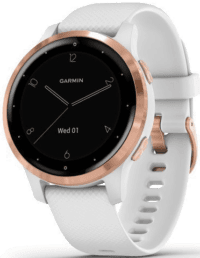
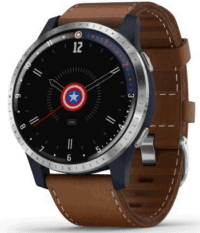
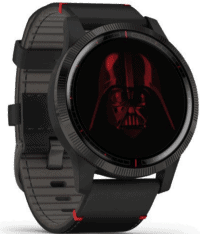
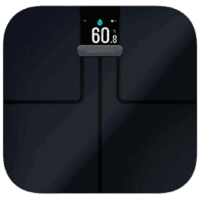
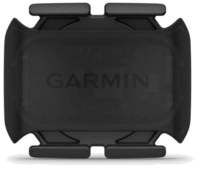
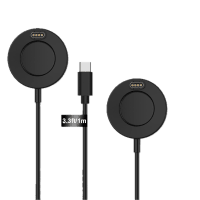


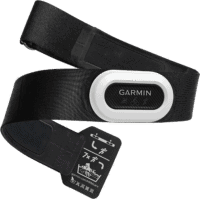





















Unfortunately this review is missing one crucial part; a video of Ray doing the Yoga poses.
Or at least a picture of Ray doing yoga poses and making a photo of his Vivoactive on the wrist. Can’t be easy to watch your wrist during yoga poses…. can the screen of the Vivoactive be ´sent´ to a nearby phone or tablet?
There’s no part of me doing Yoga that anyone wants to see. Mainly because you can’t unsee it.
Thank you very much for this review!
Light OT: please can someone tell Garmin to not count average 7days summary (calories) including this day (today), but last seven day without today? In Garmin Connect App (Android). Thank you :-)
There’s a mind boggling typo in the music section Ray: “8-10 seconds per minute”
Probably better to have said 40 seconds per song, but I totally get it
i don’t think that is a typo as one minute of the song takes 8-10 seconds to download.
Thanks Adam – should indeed be 8-10 songs per minute.
Hey Ray, quick question:
your product comparison tool lists the Apple Watch as having no crash detection for cycling, but doesn’t the “fall detection” feature also cover that? On a similar note, could you perhaps also introduce that field within the running category? I’m currently comparing smart watches to buy for my father (who already had a bad fall this year), hence it’d be great to have this as an additional filter!
That’s an interesting point. I hadn’t really thought about it in that context (mainly, because as you noted it was in the cycling category).
Fwiw – the Garmin fall detection applies to running and cycling.
[…]custom workout. These would be if you downloaded a workout from Garmin Connect or made one online or via the Garmin Connect Mobile smartphone app. […]
unfortunately custom-made workouts don´t sync to the watch, only when placed via the calendar.
known “feature” since launch, no further development from Garmin *sigh*
But The Wife still loves her VA4s (after finding out, that the VA4/Venu was a lot bigger on her wrist than her former VA3)
That’s weird. So if you try and ‘send’ a custom workout from GCM to your watch, what happens?
Garmin has never automatically sync’d all custom workouts to your watch, only workouts you specify to sync. I personally would think that in this day and age that’s a bit silly. I created them there, just sync the darn things (especially on the Edge with much larger real estate). But, that’s the way it’s always been.
custom-workout sync works perfectly with my F3/F5/945
but apparently for the VA4 series it´s broken, is known on the Garmin boards
Sorry, can you explain the exact steps you’re taking? Just want to try and repro.
Did you end up trying this on the Vivoactive 4S? I have been contemplating purchasing (I have a very small wrist) but want to be able to do set intervals. I have read on other forums that people have been having difficulty setting up custom workouts on this particular watch.
I don’t get this yoga animation piece, how is it useful? I’m not able to see my wrist most of the time when in a yoga session. If I take the watch off and place it in front of me to see the screen then it’s not recording the workout. What am I missing?
Well, you can check the poses before you do the workout. ofcourse you don’t need to look your watch the whole duration of the workout, just when you need, same as if you go for a yoga class, you dont spend whole session looking what your instructor does, you look the instructions when you need them.
Hey Ray!
In the video around the 7:50 mark you mentioned if you create your own workout, animations aren’t displayed.
On the Fenix 6, you can get around this by copying a pre-made workout to your workouts and editing your copy as you see fit. As long as the particular exercise or movement you’ve added has a built in animation, it seems to work.
Nice – that’s a cool tip!
A year or so ago, the advice for Garmin devices seemed to be to use GPS+GLONASS rather than GPS+Galileo since Garmin’s focus was apparently on GLONASS and only a few of the Galileo satellites were operational. However, time’s moved on, and so hopefully have Garmin and Sony’s software engineers, plus a whole extra bunch of Galileo satellites recently came online.
So do you know what the current advice is, or do you have your own recent opinion? And I appreciate that the answer might be different depending on where in the world you are, particularly Northern/Southern hemisphere.
Neil
I’ve been finding GPS+Galileo to be the most accurate on the latest devices, especially in tough conditions like dense tree cover on winding trails.
An FYI for other XC skiers – the VA4 (like every other Garmin I have had) fails miserably at HR for XC skiing. While at max effort (HR >160) it will never show above maybe 95. My pet theory is that bending the wrist using the poles messes the whole thing up. HR seems to work pretty well for me in other situations.
If you want HR (or calories) while skiing, you have to wear a strap.
You can try to wear the watch on the inside (meaning where your veins are).
For some this seems to produce better results in normal conditions, and with the bended wrists I would say it’s worth a try..
You can’t use optical HR for any activity involving grip-strength. Read this:
link to support.garmin.com
Skip to the section “Certain Types of Activities Can Affect Heart Rate Performance”.
You need a chest strap – or at least upper-arm optical – HRM.
170 HR is Aerobic? Holy Moly.
Quick question – I thought the Vivoactive 4 had Advanced Sleep Monitoring, which includes REM sleep category. The graphics shown though, seem to indicate that it has the older Garmin sleep metrics (awake, deep and light) that I have on my 735XT. Thanks!
Sleep monitoring was one of several reasons I returned the Venu. I own the V3 and sleep monitoring was way off and that didn’t change with the Venu. I don’t expect a wrist based consumer product to be totally accurate but it should at least get sleep times and sleep patterns to somewhat mirror reality.
I’ve gone to a much more basic watch (Amazfit GTR) that has an AMOLED display and costs half of what the Vivoactive 4 goes for onsale. I use an Edge 1000 on the bike outdoors and Zwift indoors (OH1 HR monitor) so HR & GPS accuracy is not that critical to me from the watch. It’s good enough.
The sleep tracking is much better on the GTR.
The GTR has no stair climbing which is an improvement over the VA3 & the Venu. No stair climbing beats a wildly inaccurate number that the Vivo’s delivered.
I agree , I was comparing it with Huawei GT2 and can not believe that GT2 is more precise :/
Different strokes for different folks, but I find Garmin (and Fitbit for that matter) does a great job on sleep tracking. I occasionally have to correct times only when I lie still in bed after waking up. But does a brilliant job on the nREM and REM cycles. Has helped me understand and fine tune sleep habits.
Huami probably a no go for most on this site, who want an independent sports focused watch, want the back end app, and want integration of their holistic fitness/physiological/workout data in a single platform. To say nothing of what China Inc may do with user data.
Seems a reasonable setup for an Edge owner who only does outdoor bike and indoor Zwift, though wonder if the cost savings are worth the hassle of another app. My Garmin and Fitbit watches maintain great resale value though, so on a TCO basis it’s probably the same price.
Good comment and great to see an Edge 1000 surviving!
I also want all off this and sleep is not so my concern , but GPS … I had Fenix 3HR before and I love Garmin …. actually I am just surprised why Garmin can not make it good gps when it does not seem so hard if Huawei can do it and they just make ” fun ” watch ???
>>> Garmin (and Fitbit for that matter) does a great job on sleep tracking. I occasionally have to correct times only when I lie still in bed after waking up. But does a brilliant job on the nREM and REM cycles
I am not disputing it, but I wonder how have you verified that it does a brilliant job on the nREM and REM cycles.
WHAT? Garmins Sleep Tracking is the most inaccurate thing.
I wear a FR235. Sleep was OK. Some hours deep, some light.
Change to the VA3 – my sleep are broke copmplete. 1 oder 5 Minutes deep, no rem and so on. Send it back, change to Amazfit, Huawei…..buying a Venu. The same crap. Ther take her own sleep analysis instead of firstbeat. Its useless. In DesFits Venu-Video i see the same. Deep sleep only in the first part of the night.
A nea 350€ device sahould do this jopb better as a 35€ Huawei band
Which model, 4 or 4s, is comparable in size to the Vivoactive 3? Another comment seemed to suggest it is the 4s and that the 4 is larger. Thanks.
Garmin VA4s: 40mm: 40 x 40 x 12.7 mm (wrist 110 to 175 mm)
Garmin VA3: 43,4 x 43,4 x 11,7 mm (wrist 135 to 200 mm
Garmin Venu: 43,2 x 43,2 x 12,4 mm
Garmin VA4 45mm: 45.1 x 45.1 x 12.8 mm
coming from a VA3:
VA4 on my wife´s wrist too big (“air” on both sides of the wrist)
VA4s a lot better
on the Garmin site they even post
In terms of screen size, the 4 is larger than the 3 (45m vs. 43mm) and the 4s (40mm) is smaller than the 3. The Venu (43mm) is the same size as the 3, but uses an AMOLED display. In terms of weight and overall watch size, I remember the 4 being lager than the 3 (I compared them in the store), but don’t know about the others.
One other thing to keep in mind is that the VA4s has lower resolution than the VA4. The Venu has the highest resolution.
Thanks for the excellent review. I have been using the VA4 for a month now and am not surprised by your GPS results. I feel like the watch was doing better prior to the 2.70 update, but maybe I am just imagining things. I am wondering if you noticed that (it would give me hope that a future update might improve things again). I feel like the hardware is more capable than what the software is producing.
Also, you teased in your review the ability to build your own watch face with your own pictures. Is there a Garmin or third party watch face that lets you add your own picture as the background or are you talking about a “code your own” situation? I am currently using Garmin’s blue swirl watch face with only static data displayed to stretch battery life (getting about 12 days/charge – it is amazing to me how much watch face choice and fluctuating data (like HR or seconds) can affect battery life, at least in my experience).
One other thing, you aren’t kidding about the backlight brightness. 10% is all I need. It actually has a flashlight app. I can’t imagine changing diapers to it, but I am not an exhausted parent at 4 in the morning (any more).
Yeah, it’s crazy bright (one might even argue too bright).
What’s the differentiation for this and the FR 245?
On the VA3 the crystal sits just below the bezel, enough so that a (glass) screen protector can be fitted. On the VA4 does the crystal sit the same way? I destroy all but sapphire crystals (and even then have dropped those to see them crack).
Loved mine until the 4.0 update…now I dont get any text notifications and the body battery is all jacked up.
Venu on sale for USD 299 now on garmin
link to buy.garmin.com
…and more importantly, they’ve already perma-reduced Venu list price to $349 (clevertraining is often late to editing list price).
Both Venu and VA4 pricing is mirroring almost exactly what happened with the VA3 launch in Fall 2017. Started well overpriced at $299, dropped very quickly.
Seems to indicate initial demand was soft for both of these units. Would be interesting to see what’s drivin that — GOOD (more trading up to Fenix, which has become an absolute colossus) or BAD (more of the non-serious couch to 5k crowd considering AW good enough for basic activity tracking, doesn’t use sensors etc.).
The weird part is – on the Canadian Garmin site, they also dropped the Venu, down to 399 CAD (300 USD at the current exchange rate), but left the V4/V4S at 479 CAD. They were at the same 479 CAD price, the Venu is now cheaper.
Woah – that’s a good catch JWW. Indeed, that’s a double-sale quitely not noted. The original price was $399, now $349, and now $299 on sale (Venu).
Which, not to toot my own horn – is exactly what I said at launch – it was overpriced. Garmin experimented during the fall sales with $299 and it sold super well. Clearly they’re going back to that.
For the HR tests were you running it in the activity tracking mode or just using the passive 24×7 HR monitor? I’ve noticed a big difference in accuracy – if I run the watch in an activity the HR recording is better than running the watch passively (without telling it I’m doing a work out). Is this normal?
@wes – yes that is normal
Correct, in passive mode it reduces the power to the sensor. All companies do this.
I have a VA3 can’t see anything that would make me upgrade. Mainly looks like a couple of tweaks here and there. Fundamentals like Gps and HR accuracy have gone backwards maybe?
Best thing about the VA4 is what it’s launch did to VA3 prices around Christmas. The VA3 might not have been a great value at MSRP, but it was a helluva bargain at < $120 (US).
There was even a couple moments at sub-$100. :)
Tiny bit of feedback: your watch reviews (all of them, not just this one) would be 100% better with at least 1 picture of the watch on the Girl’s wrist. Sincerely, a small-wristed lady.
I tried to compare Huawei GT2 and Vivoactive 4 . What I can not get how come Huawei seems so superior to me compare to Garmin ??? I am fan of Garmin , but this looks ridiculous . They said it might be something wrong with their unit and to send it back for checking , but after your review I am not so sure that is the case :/
Are Fenix 5plus and ^ pro any better than Vivoactive 4 .
Still can believe in this , GT2 also seems better in sleep tracking … noticing when I get up in night and more precise when I fall asleep and wake up , for HR I can not tell , but in many cases very similar .
Would be nice see you doing review of GT2
You can fit screen protector perfectly
Thanks for the in depth review. How is the readability of the screen on the vivoactive 4 versus the venu outdoors? I have a first generation vivoactive that is great in the sun and I have a Fitbit that is worthless outside for readability. Sure the venu screen looks great but if visibility is a concern then I’ll take the vivoactive 4. Thanks!
Zero issues outdoors.
Yeah, things are dramatically different than the old Vivoactive screens.
I can’t speak to the Venu’s readability, but I made the jump from the Vivoactive to the VA4, and it is similarly just as readable outdoors. I think it has a bit more gloss to it, which can create a bit of reflection sometimes (you can see it in some of Ray’s pictures), but nothing that ever causes an issue for me outdoors. Obviously a much nicer, larger screen than the Vivoactive.
Thank you both,
There is a fatal flaw for water sports – if you pause timer, one splash of water will delete your activity. This was an issue on other touch screen models too but I was able to take an extra step and lock the screen before jumping in the water to cool off. Also, the delete activity icon should NOT be adjacent the start stop button, it’s too easy to hit the delete icon when resuming the activity, I already accidentally deleted my bike ride after a break.
So on my first swim with the watch, I couldn’t figure out how to end the swim workout. I guessed (correctly) that it must be a long press of one of the buttons, but guessed (incorrectly) that it was the bottom (lap) button and it discarded my workout. Live and learn, but there should be a confirmation press required before discarding any workout.
I was hoping you would talk about the Body Battery feature. I am curious how close it is in accuracy to the Whoop(which I would also love to have you review) and how accurate it is in general. I was a little disappointed and surprised the VA4 didn’t include the training load and similar metrics as are found in the FR245, I went with the VA4 thinking the Body Battery should be enough of a metric to manage training load.
I have Forerunner 945 which has both training load metrics and body battery. In short – I would not ever rely on Body battery for managing training load. There are a few reasons I can think of, but one of the reasons at least for me is that I find Garmin’s record of HRV/stress quite suspect (and Body battery relies heavily on these measurements).
Training load however is a simpler affair and is based on HR values during exercise. As long as HR values are reasonably accurate, this should provide a truer picture.
I’d agree in general with dizpark. I find the body battery a good rough-glance indication at how that singular day is going, but not at overall training load/fatigue.
For the most part, I find body battery to be a pretty good mirror of what my body feels like relative to tiredness. I do find it seems to take at least a few days to normalize though after setting up a watch.
Ray could you say more about what IQ apps allow a connection to a BT power meter? lack of power meter connection would be a deal breaker for me.
I’ll dig up some names of apps. There were a few out there for the VA3, but some have been pulled. I saw some names float by a few days ago.
Appreciate reading your reviews Ray but I am always intrigued how you never seem to cover the accuracy of the altimeter, particularly under the GPS Accuracy section, especially in smartwatches.
I currently have a Vivoactive 3 which I mainly used for cycling, until I invested in an Edge 520 Plus, mainly because I was frustrated at the inaccuracy of the altimeter in the VA3 & its tendency to waiver or jump wildly if I paused. I think elevation is a crucial element to a ride & this led me to correct the elevation on Strava and Garmin after most rides which is a hassle but I’m fussy! Even tried a number of suggested fixes to stop this from happening such as a recorded location point from where I started most of my rides. It particularly amazes me how this wavering when you pause still happens nowadays, especially if you don’t move, as you would expect a simple piece of coding in the software would lock the elevation on what it was last recorded as before the pause?!
While it isn’t a dealbreaker, I’m looking at upgrading to a VA4 in the future and would like to know it has a more accurate altimeter before I’m convinced. Wondering if you have anything to say on this and why you don’t often comment on the altimeter accuracy?
Sometimes I include elevation accuracy sections in the reviews. It honestly just comes down to how much time I have to write it up. If I’m sliding into home with a few minutes before embargo release, then usually I’ll cut writing that section as long as the underlying data looks good. Often times I’ll come back and add it later for products that are elevation focused (mountains/etc…).
However, one thing to note is that I purposefully provide a link to each of the data set’s DCR Analyzer page, and if you tap on that link you’ll see the elevation comparison data shown as well.
For the VA4, one of the best ones to look at is this set in Australia up to Mt. Lofty: link to analyze.dcrainmaker.com
This includes stopping at the top for 10-15 mins. It looks like all-in over the course of the ride it drifted about 10m. Or perhaps the other units drifted 10m. What I can say is that since I started within a meter or two of sea level right next to the water/beach, that the Polar Vantage V was incorrect. That much I know.
Thank you for your insight! I don’t really understand why the VA4 doesn’t have the training load metrics when it seems like just a software addition.
And while it isn’t a quick-glance thing I am pretty confident I can measure my training load pretty accurately. I was hoping body battery would give me something that is a little bit more nuanced and harder to identify. Maybe I will have to try the Whoop as I have some friends who are very happy with theirs.
Product differentiation is why. And in the case of the training load metrics, those are licensed from FirstBeat, so there’s additional licensing fees for each one. While to a consumer training load seems like a single item, if you look at which modules Garmin bought for the Fenix 6 vs the Vivoactive 4, you can see just how expansive it is (5 vs 18):
Fenix 6 modules:
link to firstbeat.com
VA4 modules:
link to firstbeat.com
Hey Ray, question.
I was looking for a replacement to my Vivoactive 3 Music as I want to begin with Triatlons,but if I read it right this 4th gen still doesn’t have openwater swimming options.
So what is the cheapest watch that has openwaterswimming/running/swimming?
I don’t know about cheapest, but the Polar Vantage M has open water swim and is somewhat less expensive than the VA4. I only dabble in triathlons and figure the VA4 is good enough to track all my training (I don’t train in open water). There are some third party triathlon apps for the VA4 (probably work with the VA3 also, but I don’t know for sure), but I haven’t tried them out and I don’t know how much they could do if the tri has an open water swim. I have read that some people stick the watch in their swim cap so they can track distance in an open water swim, but I would think then you miss out on the other data that you can track in a swim, so not an ideal solution.
Hello Mike,
it the heart rate accurate in indoor swimming or at least decent?
Thank you
Good overall review, but you’re missing the biggest feature to compare to the Apple Watch, which is really this watch’s direct competitor as opposed to the Fenix: how well do notifications from the smartphone work and what are you interaction options on the watch?
I covered it briefly within ‘The Basics’ section. I say briefly, because there’s not much to cover. You see a non-interactive message from any notification on your phone. Apple locks down responses, so 3rd party devices like a Garmin watch can’t actually respond to texts or such (whereas Apple can with their Apple Watch). So it’s mostly just a one-way note, along with the option to clear (which does clear the notification on the phone as well).
On Android with texts my understanding is you can respond in a limited fashion, though I haven’t tried that.
Hi Ray, thx for a great review. About GPS accuracy; my Venu shows unrealistic speed-spikes while rowing under a bridge. This making the Graphs unreadable. I tried all the different Satelite possabilities, but the recordings always show spikes for bridges or overpasses. Can I do something about that or should I just wait at the next update?
Regards Peter
Hmm, that would probably make sense to be honest. In the case of running, it switches over to accelerometer based distance and pace (I run under a lot of bridges). But I don’t believe that exists for rowing (or, at least, I’m not aware of it).
So it’s just plotting the next point plopping out the other side. Typically though you’re going to see some GPS quirks when it does that though.
Hello, anyone tried them in swimming in open water?
It doesn’t have an openwater swim mode, so basically the GPS track will be pretty much hot garbage. :(
But you can use it in open water without risk of damaging the watch?
Would those here recommend trading in a Vivoactive for a 245?
I’m really puzzled myself by the heart rate monitor performance. I’ve experienced it myself, even though it’s the same sensor in the 945 and 245 which have gotten really great reviews. I love the smart watch features to this watch but some of the run away freight train heart rate data I get really has be thinking about switching out for the 245. I have a polar vantage m and feel like that gives me better active heart rate data especially when it comes to recovery moments. The Garmin heart rate will at times just keep climbing during rest and seems to get stuck at a really high number, while the polar has a nice smooth descent to it.
Plus polar sleep tracking is significantly better. I just wish polar would make an activity focused smart watch.
Hey Ray,
Long time listener, first time caller. Amazing review as usual! Just a quick question, are the issues with the optical HR sensor software related that Garmin intends to rectify soon? I definitely find that the HR tracking on mine is practically unusable when cycling, super disappointing compared to the VA3 and VA3 Music that I have had before this. Thanks!
gavin
Dcrainmaker eres un emblema y referencia para todo el apasionado de los dispositivos portátiles !! Sobresalientes tus trabajos
Yo creo que es un dispositivo muy completo, que no tiene nada que envidiar a los relojes “específicos deportivos”. De hecho creo que cada vez hay menos diferencias entre el segmento de los Vivo Active, y el de los Forerunners.
¿Sabemos si en una futura actualización del Vivo Active 4, podrían incorporar métricas como el Estado de Entrenamiento, o Tiempo de Recuperación?
Para la gran mayoría de usuarios, ya sería el reloj perfecto
Thanks Ray for this review
I just purchased it but was disappointed that Wiggle (UK) didn’t stock it to help you out. Wiggle is my default supplier for most sports things and they do stock most Garmin watches.
Anyway I chose this over the 645 music based using your analysis tool, as far as I can see all I am losing is the HRM dynamics but gain more sports and crucially significant software longevity and enhanced functionality from potential software upgrades. (I will continue to use my 920xt for races etc so HRM won’t be a big loss)
Is that your assessment?
Just got the ver. 2.8 update for the GPS. Hopefully this will make things better and (gulp) not worse. Be careful what I wish for I guess.
Today, with less than a month my Vivoactive 4 stuck on boot logo right after a request for update on the watch screen and it doesn’t start/restart anymore. I’ve tried hard reset, farm in express, nothing.
Never happened with my Suunto Spartan Trainer, still reliable with more than two years. Garmin again? Thanks, but no thank you.
What do you think is a good accurate GPS watch from Garmin?
Thanks for the in depth review!
Can you comment on its durability? I’m planning on buying a smartwatch for obstacle course races like Spartan. Can you comment on it being scratch proof or can it withstand bumps or falls.
On my old VA HR, I can set heart rate zones related to the difference between maximum and resting heart rate. On my wifes new VA 4s, she can only set heart rate zones as a percentage of maximum heart rate. Has the feature been removed?
Very nice article, thanks for more information. Want to Sell Smart Watch ? You can buy it from volgopoint online shopping with cheapest price, with free shipping and free delevery worldwide.
VolgoPoint Smart Watch
Are there watches, that can TrueUp cycling training load from Edge 830, so that I don’t have to review cycling load on Edge itself or Gramin Connect, but I can review it on watch? Now I get that Vivoactive does not have training load, I have it on my wrist :-). But if I get Forerunner or Fenix, which both support training load, will the watches only show load from activities recorded with them, or will it also sync in cycling load via TrueUp? Thx!
I am still confused between Vivoactive 4 and Venue, should I pay $25 more just to get that better display?
btw, a kickass article, really thorough
I was going to because I’m used to a shorter battery life anyway and it really is beautiful… until I realized that the Venu is a little bit bigger than the Vivoactive 4S. I think the 40mm (4S) would be better for my small wrist than a 43, which is not as large as the larger sized Vivoactive 4 (45mm).
Can you make a hike of a day with this watch and everything is registered?
I currently have a Charge 2 and am looking to investing in a smartwatch. I am considering the Vivoactive 4 or Venu. I mostly do a variety of group exercise (indoor cycling, pilates, many HIIT training formats, TRX and more) and like seeing a breakdown of calories lost, how much effort was expended etc. I’m wondering if it’s worth it to go this route rather than a Versa2 or if that would essentially perform just as well with logging group exercise workouts. I would rarely use the personal training modes and am not a runner. Being able to respond to texts via the watch is also tempting, currently have a GalaxyS8. Just wondering if it’s worth the price jump from a FitBit Versa2.
Shop smart watch At Volgo Point, Low Prices & High Quality. Explore many Genuine Brands, visit us and Enjoy massive discounts on the best Smart Watches with global free shipping.
Have Garmin addressed the GPS problems yet?
I rarely share my story with people, not only because it put me at the lowest point ever but because it made me a person of ridicule among family and friends. I put all I had into Binary Options ($690,000) after hearing great testimonies about this new investment strategy. I was made to believe my investment would triple, it started good and I got returns (not up to what I had invested). Gathered more and involved a couple family members, but I didn’t know I was setting myself up for the kill, in less than no time all we had put ($820,000) was gone. It almost seem I had set them up, they came at me strong and hard. After searching and looking for how to make those scums pay back, I got introduced to sophiawilliams9615@gmail.com to WhatsApp her +18454500578.who helped recover about 80% of my lost funds within a month
I have a specific question that i have not yet found the answer too, on the internet. What would you say is the battery life of the watch, with constant 24/7 heart rate and 24/7 Pulse Ox enabled and sleep of course, without much else used (GPS, music, etc.) and a few workouts per week?
About 3 days.
Does the screen on 4 look any better than on 4s due to the higher resolution?
Are there any practical advantages of having higher resolution screen? Meaning, can apps take advantage of those extra pixels and do we actually get more information visible on screen or is everything optimised/scaled and looks similar anyway? I would imagine (please correct me if I am wrong) the native Garmin apps will look pretty much the same but what about third party apps? Are there any apps you could think of that would benefit from the extra resolution?
Many thanks for your input.
Nice review. Unfortunately you can only review the firmware on the device you’ve got. Garmin can, and do, push out new firmware that you can’t avoid (without avoiding Garmin connect entirely) that drastically changes the specs.Changing, for example, the accuracy of the HR monitor or, as they’ve done a couple of times for the Vivoactive 3, reducing battery life to 5 hours.
Hi Ray
Am looking at either the Vivoacive 4 or the Venu but have a couple of questions.
My wife’s Vivoactive3 Music seems to have a 6 second delay from pressing start before it records time or distance (we are waiting until it says “ready”).
Is this a “thing” with the garmins or are we using it incorrectly?
Secondly, does it have a biathlon/triathlon regime inset, or do these need (with transitions) to be built up as a personalised routine?
To answer my own questions
… it turns out thew “AutoPause” needs to be turned off, otherwise the timer stops whenever you are doing less than a preset min speed.
.. and you need to upgrade to the (higher-end) fenix models to get biathlon modes.
Seems a bit stingey, as this can’t be anything other than software.
I currently am still holding on to my origin Vivoactive. I love it but my biggest issue is that during a run or walk or swim I cannot see what time it is… Is this an option on customizing screens with any of the other newer watches?
Danielle
I had similar issue (original Vivoactive) until I realised I could configure one of the walking screens to show actual time as a field. Also with both indoor and outdoor cycling. So yes you can do it on your current watch, so presume (hope!) you can do it on the newer ones.
Am looking to upgrade, and torn between (cheaper) VA3 M and a VA4 … decisions decisions!
I had the Vivoactive, now use the VA4. With the Vivoactive, you can customize the data fields displayed when you run to include current time as a field. I think you press the menu button (the three bars at the bottom of the screen) while in run mode to bring up options including 1 to customize data fields.
I recently purchased the VA4 and I’m happy with it, I just wish I had training load/recovery/etc. Since the data is likely being collected anyway, is anybody aware of a 3rd party app that will calculate these metrics?
Has anyone found a connect IQ app that adds cycling power meter support?
X
Does it seem like Garmin has a 12-16 month cycle for new Vivoactive watches? Just trying to figure out if they’ll be a new Vivoactive 5 this year or early next year. :)
The vivoactive 4 screen resolution seems much higher.
How does vivoactive 4 compare to polar vantage m from sports watch perspective? I’m looking to upgrade from polar m200. I have been using various polars for years now. My main sports are squash and tennis but I do dports in general. Recovery times and training loads are something that comes handy in polar flow. If I understand correctly vivoactive does not offer that. Also how does polar flow compare to garmin connect? Thank you.
Hello
I really enjoy your comparisons and informative posts :)
Can you synchronise podcasts and audiobooks?
Hello,
Can anyone confirm / deny that subsequent firmware updates have fixed the issues that Ray highlighted in the original review – GPS / HR?
Cheers!
Can you control the music that is playing on your phone with the watch?
Thank you socmuch this was amazing
Love all your reviews but a question on this watch either not covered or it doesn’t support it…does it have a virtual pacer or similar? Thought I saw it somewhere
Hi, My wifes vivoactive 4s does an Autosave of her activities after 120min, how can one deactivate this function ?
One thing I didn’t see any mention of that I am very curious about is how many Connect IQ data fields can be used per activity?
I have the Vivoactive 3 Music and each activity is limited to only two Connect IQ data fields per each activity, which is very limited.
The limit is 2 on all Garmin devices except for the 735xt, which for some reason allowed 3.
Oh okay, shoot that’s too bad – I miss having at least one Connect IQ data field per data screen at the very least. I’m spoiled when biking as my Garmin edge 520 Plus allows 10 per type of biking activity but lots more memory to work with I suppose.
Curious if anyone has found a glass screen protector for the 4S.
I haven’t been able to get a glass one possibly because its touch screen? But have a normal protector I got from eBay hopefully that will do
I am upgrading from a Samsung galaxy active, I would like to consider myself a runner. I am training for a marathon and while most of my exercise is running I do yoga, strength training. My big draw to the Vivoactive for is golf feature because I do play often and love the idea that I could track that. So I’m in between this and the FR 245, which doesn’t have golf :-( . Basically my question is will the vivoactive 4 battery be sufficient for a marathon or should I give up the golf features and go for the 245?
My wife and I appreciate the VA4 review. She has a VA3 and had a forerunner before that. Using the amazon link on the left we got a VA4. This VA4 will be my first smartwatch (yeah, I’m old-school, I know), but figured between this review and the wife being a Garmin smartwatch veteran I’ll be in good hands. This site is our first and only stop to research fitness technology. Keep up the good work.
A great review, though I notice this watch doesn’t appear in your database search for hiking watches, despite having a barometric pressure sensor / altimeter.
I’m very confused by the sizes quoted by garmin. The 4s is 40mm, the 4 is 45mm, yet the displays appear to be 27mm and 33mm respectively. Is this the overall bezel? I’m coming from an Apple Watch, where 42mm refers to the actual display size.
What would be really useful is if your reviews included full dimensions of the watch. To estimate the fit on my wrist I really need to know the distance between the pins holding the watch strap and the actual size of the display to view.
Hello, does anybody know the degree of accuracy of the HR while swimming?
Thank you very much.
Great article – however want to see how music volume control works – do you use the buttons on the side or the circular dial like on the old vivoactive model? Thx for clarifying
I am a petite female. I currently wear a VA for daily use because of its size and switch to a FR230 for running because I like to have 4 data fields to see last lap pace v. current lap pace. I am looking to upgrade to a single watch and am considering the Venu SQ and the VA4s. It is my understanding that the Venu SQ only has three data fields per screen, but that the VA4s has four. Is that correct?
Also, I sometimes like to set intervals on my FR230. Am I understanding that I cannot do this on the VA4s? If not, how does one do an interval workout without constantly looking at the watch?
Are you able to shut off smartphone notifications? If so, how will that affect battery life? I don’t really want a smartwatch, I am really just looking for a fitness watch and am wondering how long the VA4 might last without those notifications turned on. Any other suggestions for watches in this price range that might be a better fit for HIIT (VA4 is $225 on amazon right now)?
I guess I should note I use an H10 chest strap for all my workouts (I do CrossFit), since that is more accurate.
Hi, in a in depth review, It would be nice to mention features that are now gone missing since the previous iteration of the watch. For example, Recovery Heart Rate is no longer displayed on the 4/4S and Venu. This feature was available in all previous iteration of the VivoActive line.
I would like to update my comment, as it turns out, just like its previous iterations, it does display the Recovery Heart Rate at the end of an activity but unlike in previous versions, it doesn’t stay until you touch the screen. I must have missed it, sorry.
Amazing review, hard to find in-depth review like this. Keep up the good works :)
Two weeks using Vivoactive 4s and the HR monitor was indicating my heart rate to the roof. I thought I was having a heart attack so after a few hours of a anxiety I decided to try my old Fitbit to realize that the HR monitor was malfunctioning. To keep it short, I turned off my 4s and now it does not want to turn on or better yet, is turning on with encrypted data and does not allow me to use the device. Very disappointed! Garmin is doing a great job creating good reviews but nothing about independent reviewers giving an honest assessment. I assume this review will never appear in your feed of comments.
I have VA4s since Christmas, and noticed that during sleep, but not only, it skips recording HR and SPO2, sometimes for an hour.Sure enough, sleep patern is totaly messed up.
Setings are to record by second, not smart record.
Is it a software issue, or, my unit has “personality”?
Hey Ray,
Do you know if there’s a difference between the Venu and the vivoactive for HR and GPS in favour for the Venu? In other words, is the Venu more accurate?
Greetings,
Shanti
Nope, same GPS & HR chipsets in both.
Cheers!
Thanks a lot for your quick answer :-)
I have a garmin vivoactive 4 and uses the Golf App a lot. Unfortunately the GPS accuracy, i.e. the distances to the green, seems to be inaccurate. I play on the Ruimsig Country Club in South Africa. Is there perhaps an update on the Golf App that can be applied or must I live with this inaccuracy?
Hello
I am looking for a decent watch to track accurately indoor swimming HR. is this watch do a good job to track HR in the pool. Any other suggestion for the best watch for tracking HR in the pool?
Thank you
Hi there. Love these reviews and come here often when shopping for others. Can I have functionality and resilient beauty with the white band and rose gold trim? Just splurged on the first smart watch for myself when it went on sale: the Vivoactive 4s. It just arrived: I have small wrists and it fits great. Is there any feedback on the durability and stain resistance of the white band and rose gold? I love the way it looks, but it’s a big splurge for me and if it won’t stand up to wear and tear and discolours I don’t want it. Should I return it for a more resilient black?
Functionally trumps beauty for sure….but can I have both with this?
Would love to know your opinion with this versus the Garmin Venu. After reading and researching A LOT it really just seems like it comes down to battery life and AMOLED display. But after reading your review here, it seems like the HR is slightly better on the Venu. Any tips on that? I do a lot of indoor spin cycling, HIIT workouts and outdoor running and having decent HR is important to me. That said, I usually use my Polar H10 chest strap and know it can get connected.
Why did you not mention that the auto-pause feature also auto-stops the activity after a few seconds (30?)?
This is insanely infuriating – adidas running (my only reference point) on the other hand actually just pauses the activity with auto-pause on. So that unintiuitive behaviour seems to be a Garmin thing.
Also, while running and gestures enabled as they are by default, the backlight is basically always on. Super annoying. No workaround other than turning backlight completely off as the backlight-sensitivity setting on “low” is still way too high.
I’m completely new to running watches so I had to read tons of reviews and ended up, which I never do but I was still lost, buying versa 3, vivoactive 4 and vivosmart 4. I’m really disappointed to stumple across easy-to-detect broken features on the watch I decided to keep despite reading so many reviews. Kinda disappointing. Writing this while still sweaty after my second run with that watch. I’d lie if I said I’d return this one as well, but man, why can’t expensive stuff just work -.-
Mostly because most runners don’t use auto-pause on runs. Auto-pause is designed to do exactly what it says: Automatically pause.
Thus, if it thinks you’ve paused, then it’ll pause. That can be due to stop-lights, but also poor GPS reception.
If you’re having issues with it pausing all the time, you can adjust the sensitivity of it, which usually sorts it for most people. Set the sensitivity higher than you’d expect – so that it only triggers when you legit come to a full stop: link to www8.garmin.com
Hey Ray
Thanks for an outstanding review. Thanks to this I purchased the watch in August last year. Also purchased a Kickr Core thanks to your review three weeks ago.
Whilst I do trainerroad workoads independently to the watch, is there a way to merge the wrist HR data with the TR workout to your knowledge? I’ve been googling and re-reading reviews like yours but am going round in circles :)
thanks
Hi Ray,
Thanks for all the information.
Between the vivoactive 4/4s and forerunner 245 – which would you recommend for a woman who mainly swims and at times runs?
Does the VA4 support Connected GPS? I go on long bike rides and always carry a phone so prefer extend battery life. Currently using Fitbit Charge 3 like this which works very well (except I cannot read the screen outside!)
its a gimick most of its based around heart rate variability…body battery is not configurable, goes to 5% and stays there, stress is just hrv x a number, which you cant change and is always high,vo2 max is just max hr/min hr x 15 and is a crock,the o2 blood % never changes and is inaccurate…heart rate and time works thou.
Thanks for the video and long description of the watches. It helped me to figure out how it works. I had a 3 generation watch and it is very different . Thanks again.
So what would be better the garmin vivoactive 4 or the polar vantage m2? I use it mainly for gym and some running though I am not too concerned about gps accuracy. The music functionality of the garmin would be nice to have but it is not something I really need.
So purely based on heart rate tracking accuracy what would you suggest?
Thanks for the great review. I’m looking at stepping into the Garmin world and confused by the number of different models. Currently my activities that i’d like to track are hiking/walking on the weekends, rowing data using my concept 2 (currently using the ergData app to track and sync to Garmin connect) and general HR while strength training. On top of this general health and fitness data over time. Would a Vivoactive 4 be suitable for this ?
Thanks for a very thorough review. It helped me decide to get one during Amazon Prime days. A note that I was pleasantly surprised when I selected indoor cycling workout mode and it automatically found my Tacx trainer and captured distance and speed.
Excellent article, thank you.
The Yoga protocol of the Vivoactive 4 can measure respiration rate. As far as I know, respiration rate calculation from wrist based HRMs are only accurate at rest. What happens when the Vivoactive 4 is connected to a chest strap? Respiration rate calculation requires R-R peak data, the distance between two ECG peaks. Does the Vivoactve 4 Yoga protocol calculate respiration rate from chest strap R-R data when connected to a chest strap? Or is for instance a Forerunner 945 necessary for chest stap respiration rate data?
Can anyone tell me what the difference is with the international version? Im in Australia and some of the sites are specifying its an International version but not how this is different.
Hi.
I am about to buy a vivoactive 4 to replace my Vivoactive HR which only charges occasionally and I want spotify offline support and the “new” BTLE Connect IQ API among other stuff.
But I keep reading about a vivoactive 5 which might come this year. Anybody know how likely that is and if it may be worth a wait?
Anyway thanks for this detailed review which makes me want to have the thing.
So I’m currently thinking I want either the Fitbit Charge 5 or the Vivoactive 4, but choosing those two on the comparisons page isn’t possible. That would be really helpful since I’m confused about some of the sensors and if they’re comparable. Also, any updates to this review? Part of the reason I’m considering the Vivoactive is because it has the Readiness score without any premium subscriptions. Have you explored the Garmin Readiness score? How does it do?
I have quick questions;
1- Garmin Spec says Vivo4 does not show Running Dynamics (but FR245 shows with Pod). But you show Running dynamics in your photos. I confused.
2- Can I get Aero and Anaero data from vivo4?
2- What is the nutrition data on your workout? Does vivo4 shows that?
Also I need your help,
I have base Instinct. But I did not check that base model does not suitable for underwater HR. What a pity! So, I need another watch that shows at least my performance index while swimming.
I am looking Venu2, Vivo4 and FR245. Alternatively, I can also sell my Instinct and buy Solar version.
Fenix 6S Sapphire has really good discount. (around 500 dollars)
However, all models I mentioned has V3 HR Sensor from 2019. But, Garmin may announce newer versions of Fenix and Forerunner in 2022. That’s why I am thinking. What should I do?
Do you have a suggestion for me. I really want Fenix 6s. I live in Turkey. But here in Turkey the currency is 16/1 :(
Shall I buy cheaper watch such as FR245 or Vivo4 (around 200 dollars)? Thus I can use instinct for outdoor, others for indoors. I also suspect the touchscreen of vivo4. What do you think?
Sorry for my long question but I need an expert view.
Thanks
According to Garmin, the Vivoactive 4 can display respiration rate through the Respiration Widget and as a data field for either the Breathwork or Yoga activity profiles. As far as I know, respiration rate calculation from wrist worn optical heart rate sensors is only accurate at rest. Is it possible to use a (HRM-Tri, HRM-Run, HRM-Pro, or HRM-Dual) chest strap for Breathwork or Yoga activity profiles, to get accurate respiration rate calculations also when the body is not at rest?
When I swipe to the left on my Home Screen, it brings up the “flashlight”. Is there anyway to change that. It’s annoying as I seem to accidentally turn it on.
What are the dots or lines that look to be permanent on the inner watch face bezel for? Or can it be turned off? In some pics it looks like dots and others lines.
Very useful review! I need also a more basic article in how to set everything up. Also I’m trying to decide of I should return the vivoactive for the venu2s.
Thanks!
For years, I’ve had trouble with my VA4 and my Motorola X4 Android phone pairing up and staying paired. I had to delete and re-add so many times per month, I almost gave up on the combo. But ~2 weeks ago, Garmin updated the Bluetooth on my watch and OMG!!! I haven’t dropped Bluetooth since – not even once! I feel like it’s a whole new experience now. I can use my on-watch music with any number of headphones; my steps, my stairs climbed, heartrate, etc. now seemingly update in real time. Thank you Garmin, for bringing this watch/phone combo back to life for me!! You just picked the thorn out of my side…tb
The sad truth is that the Android Bluetooth Stack is a buggy mess. After almost any Android update I had at lease one BT device fail to communicate because google broke their stack again or workaround for older bugs in apps did not function anymore. It also does not help that many vendors modify the BT stack on their own. So I would attrbute your problems more to the Android side of things and not Garmin.
That said – in the half year I used the Vivoactive 4 until I upgraded to a fenix (because VA4 has very strange limitations) I never had problems syncing. I did have problems with a background app that fetches some values every 5 minutes from the phone that worked very unreliably – even more so on the Edge 1030 than on the watch. That works much better now, so I think Garmin has found a good workaround for the Android problems now.
This watch doubles your heart rate when rowing! Garmin says they can’t do anything about it and to wear a chest monitor. It also can fail to connect to satellites if you travel some distance from your exercise area then return. It needs a complete restart to reset its satellite recognition system. Otherwise an excellent way of keeping fit – using intensity minutes as a guide. At 76 years old we (M&F) both usually manage 300+ per week! However rowing skews it badly.